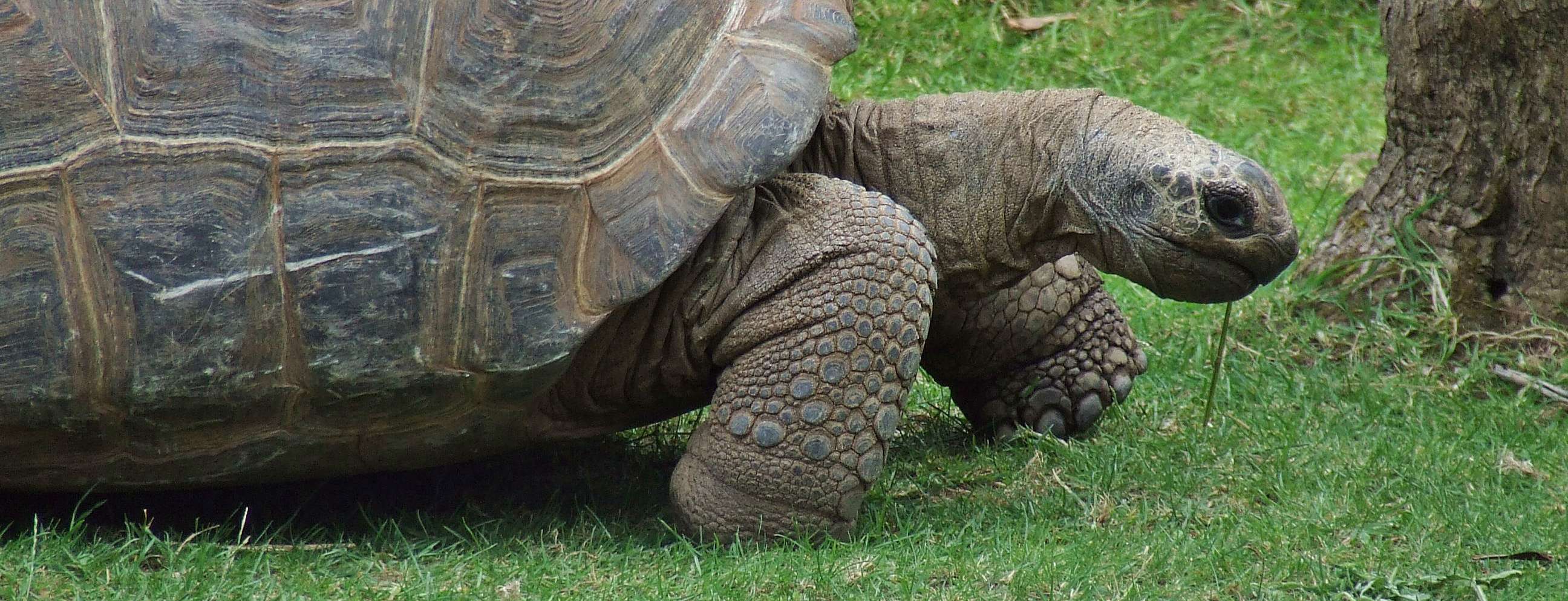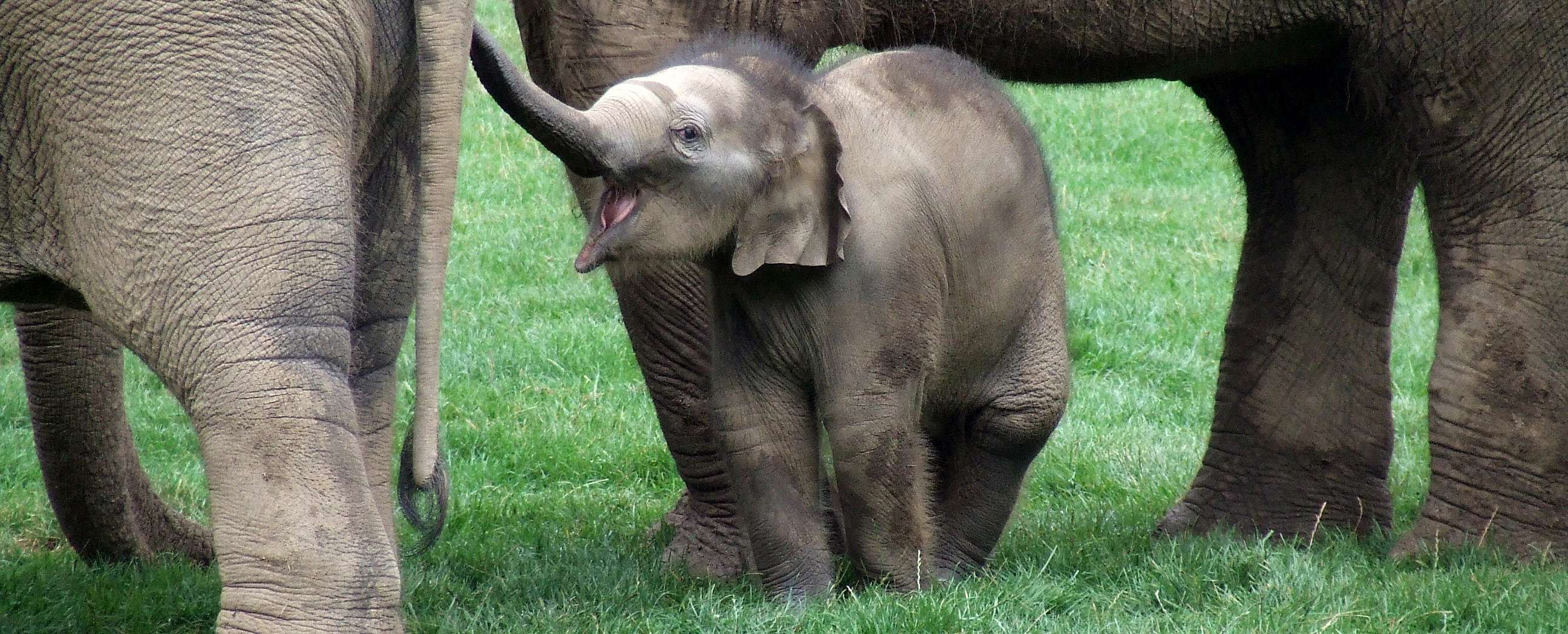Európa állatkertjei
ZOOlogical Gardens of EuROPE

MIXED-SPECIES EXHIBITS WITH CARNIVORANS I.
Mixed-species exhibits with Bears (Ursidae)
Written by KRISZTIÁN SVÁBIK
Assistant Curator, Budapest Zoo and Botanical Garden, Hungary
12th April 2012
Uploaded: 4th August 2019
Refreshed: 5th May 2020
INTRODUCTION
The success of a mixed-species exhibit depends on how we can take general animal husbandry criteria into account in more complex ways in comparison with a single-species exhibit. Those general rules that are important in animal exhibitry are still valid to a greater extent when presenting a multi-species captive environment. As many articles and other publications deal with the subject of general advantages and disadvantages of the mixed-species exhibits, instead of this, here I will assemble a detailed list of mixed exhibits involving at least one member of Ursidae.
Use of space and enclosure furnishings
Generally speaking, one of the most critical factor is the size of the area: the larger the enclosure, the fewer the problems. Since most of the Ursids are powerful and territorial animals, by expanding the size of the whole captive habitat we can greatly increase the chances that the specimens of the different species are able to get out of each other’s way. Although this quantitative factor is also important, however, the quality of the given enclosure is much more crucial, since these agents can ensure the stress-free socialization of the combined species. It is extremely important to provide a secure outdoor and indoor space for the subdominant specimens whether belonging to the same species or not. The outdoor exhibit should be well-structured with many kinds of enclosure furnishing elements like small mounds, logs, rock formations and heavily planted areas so that the animals can get out of visual contact with others sharing the same enclosure and provide several escape routes in case of an aggressive contact between the different species. The best option is if the species mixed with the Ursids have their own „bear-proof” areas both outdoors and indoors.
Feeding
In terms of the daily routine tasks using the appropriate feeding techniques is one of the key factor of success. The experiences show that in several cases other carnivores, like coatis, otters and mostly smaller canids have been combined with the bears, which can be easily competitor species in reference of nutrition. Therefore it is necessary to feed the mentioned smaller species separately or provide as many feeding stations as possible throughout the whole enclosure and keep the competition to a minimum level, because most of the injuries and lethal accidents are the results of food-related aggression. In general, feeding the different species separately is a participating factor to manage the mixed-species exhibit successfully, but on the other hand this makes it difficult to apply certain food-related environmental enrichment methods in comparison with a single-species enclosure. For example, the use of scatter feeding can be safely applied in case of a very large enclosure. With the exception of a few species, most of the Ursids’ natural foraging behaviour means that the animals need a large amount of time to find, collect and consume small and scattered food items, therefore it is practical to provide a captive environment as big as possible in order to eliminate the competition between the carnivore species.
Breeding
One of the most important question is to decide whether we would like to breed the species involved in a multi-species exhibit, or which species we want to breed. The practice of zoos keeping bears in a mixed exhibit shows that the presence of these powerful animals means potential danger for the other species whether they are dominant or subdominant in the given coexistence or not, just think about the many inexperienced juvenile wolves and foxes that have been killed by bears in captivity. Providing the above mentioned „bear-proof” areas or total separation can be the solution during the time of rearing the young. Furthermore, the behavioural changes of the adult animals during the breeding season must also be borne in mind which may easily lead to fatal injuries. Therefore it is really important to emphasize the possibility of proper separation because there are only a few known cases when the offspring of a non-bear species have grown up successfully with the constant presence of the Ursids. Generally speaking it seems to be true that the proper management of breeding in a mixed-species enclosure is more difficult – or sometimes impossible – than in a single-species exhibit. As a result, there is no aim to breed (all) the animals in this type of exhibitry in many cases, so sterilisation and single-sex grouping are also applied techniques in managing, and the latter is common where brown bears are being housed with grey wolves. If any of the species has an important breeding programme like EEP or SSP, it is worth to look over and analyse all the mentioned disadvantages before putting the given animals into a mixed enclosure.
Choice of species and individuals
According to the criteria of species selection, most of the known examples show that zoos exhibit animals together from the same geographic region for educational purposes. In case of combining species that occupy similar ecological niches in nature the level of competition can be very high, therefore a large difference in body size between the combined species may be part of the solution. Choosing animals with different lifestyles – for example terrestrial-arboreal or diurnal-nocturnal – might be a good option as well, like in many zoos where they are housing Ursids with different fox species. In contrast with that the bears may also be the subdominant inhabitants of the enclosure when sharing the space with large herbivores. Although considering the theoretical approaches of the appropriate selection of species are also very important, we have to take into account that the success of the combination depends mostly on the individual level, simply because of the diverse individual characteristics of the animals in terms of behaviour. Correct introduction of the different species is a very sensitive issue which depends principally on the method of socialization and age of the animals. Introducing the smaller and subdominant species to the exhibit can be efficient due to exploring the whole area before the bears. During the socialization the principle of gradience should be followed, so visual and olfactory stimuli have to be the first before the possibility of physical contact of the animals. In general younger animals can be combined easier, but the experiences have shown us the contrary of that in case of Ursids. While the older individuals mostly ignore the other species, the young bears are more agile and their extremely curious and explorative behaviour sometimes leads to unpleasant harassment for the subdominant smaller animals.
List of mixed-species exhibits involving Ursids
This document purposefully focuses on creating a list of mixed-species exhibits with family Ursidae, for further and detailed information it is worth contacting the institutions mentioned below. Only a short summary of the general experiences is given here. Many of the listed coexistences are still ongoing at present; many of them are not anymore.
Within the narrower meaning of the mixed-species exhibits this document deals with seven species of Ursids with an exception of the Giant Panda (Ailuropoda melanoleuca).
In the list below you can see which species have been kept in mixed exhibits in captivity:
Brown Bear, Ursus arctos Linnaeus, 1758
Polar Bear, Ursus maritimus Phipps, 1774
American Black Bear, Ursus americanus Pallas, 1780
Asiatic Black Bear, Ursus thibetanus Cuvier, 1823
Sloth Bear, Melursus ursinus Shaw, 1791
Sun Bear, Helarctos malayanus Raffles, 1821
Andean Bear, Tremarctos ornatus Cuvier, 1825
LIST OF SPECIES COMBINATIONS - URSIDAE
The list shows examples of species combinations with at least one ursid species combined with the taxa below with references
Brown Bear, Ursus arctos (Photo © Krisztián Svábik)
Lion, Panthera leo
Eurasian Lynx, Lynx lynx (HAMMER 2002)
Red Fox, Vulpes vulpes (ASAKURA 1968, ASKELUND 2012)
Corsac Fox, Vulpes corsac (DIJKGRAAF 2012, REICHLER-DANIELOWSKI 2012)
Arctic Fox, Alopex lagopus (GÜRTLER 2012)
Golden Jackal, Canis aureus
Grey Wolf, Canis lupus (BLANC 2012)
Wolverine, Gulo gulo (ROSSET 2007, 2012)
American Black Bear, Ursus americanus (HAMMER 2002, MÜLLER-SCHILLING 2012)
Polar Bear, Ursus maritimus (HAMMER 2002, MÜLLER-SCHILLING 2012)
Asiatic Black Bear, Ursus thibetanus (HAMMER 2002, MÜLLER-SCHILLING 2012)
Sloth Bear, Melursus ursinus (MÜLLER-SCHILLING 2012)
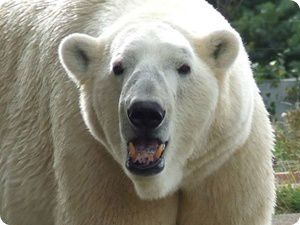 Polar Bear, Ursus maritimus (Photo © Krisztián Svábik)
Polar Bear, Ursus maritimus (Photo © Krisztián Svábik)
Arctic Fox, Alopex lagopus (THOMAS 1968)
Brown Bear, Ursus arctos (HAMMER 2002, MÜLLER-SCHILLING 2012)
American Black Bear, Ursus americanus (HAMMER 2002, MÜLLER-SCHILLING 2012)
Asiatic Black Bear, Ursus thibetanus (HAMMER 2002, MÜLLER-SCHILLING 2012)
Sloth Bear, Melursus ursinus (MÜLLER-SCHILLING 2012)
Ursus maritimus x Ursus arctos (Polar Bear/Brown Bear hybrid)
Silver Fox, Vulpes vulpes var. argentata
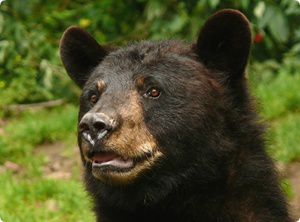 American Black Bear, Ursus americanus (Photo © Silke Arend)
American Black Bear, Ursus americanus (Photo © Silke Arend)
Rhesus Monkey, Macaca mulatta
Guinea Baboon, Papio papio
Hamadryas Baboon, Papio hamadryas (HAMMER 2002)
Northern Plains Grey Langur, Semnopithecus entellus (AMES 1998)
Black-tailed Prairie Dog, Cynomis ludovicianus (GAGNON 2012, LUBIW-HAZARD 2000)
Lion, Panthera leo
Tiger, Panthera tigris
Puma, Puma concolor (HARRISON 2012, POWELL 2012)
Red Fox, Vulpes vulpes
Grey Fox, Urocyon cinereoargenteus
Arctic Fox, Alopex lagopus
Grey Wolf, Canis lupus (HAMMER 2002, HARRISON & POWELL 2012)
Brown Bear, Ursus arctos (HAMMER 2002, MÜLLER-SCHILLING 2012)
Polar Bear, Ursus maritimus (HAMMER 2002, MÜLLER-SCHILLING 2012)
Asiatic Black Bear, Ursus thibetanus (HAMMER 2002, MÜLLER-SCHILLING 2012)
Sloth Bear, Melursus ursinus (MÜLLER-SCHILLING 2012)
Sun Bear, Helarctos malayanus
Kulan, Equus hemionus kulan
Collared Peccary, Pecari tajacu (AZA UNGULATE TAGs 2017)
Bactrian Camel, Camelus bactrianus (HAMMER 2002)
Moose, Alces americanus (GAGNON 2012)
Wapiti, Cervus canadensis (GAGNON 2012, LUBIW-HAZARD 2000)
White-tailed Deer, Odocoileus virginianus (GAGNON 2012, LUBIW-HAZARD 2000)
Reindeer, Rangifer tarandus (GAGNON 2012, LUBIW-HAZARD 2000)
Muskox, Ovibos moschatus (GAGNON 2012, LUBIW-HAZARD 2000)
Aoudad, Ammotragus lervia
Mountain Goat, Oreamnos americanus (LUBIW-HAZARD 2000)
Bighorn Sheep, Ovis canadensis (GAGNON 2012, LUBIW-HAZARD 2000)
Addax, Addax nasomaculatus (HAMMER 2002)
Arabian Oryx, Oryx leucoryx (HAMMER 2002)
American Bison, Bison bison (DUBOIS 2012, GAGNON 2012, PIGNOREL 2007)
Ostrich, Struthio camelus
American White Pelican, Pelecanus erythrorhynchos
Canada Goose, Branta canadensis (AZA UNGULATE TAGs 2017)
Mallard, Anas platyrhynchos (AZA UNGULATE TAGs 2017)
Mexican Duck, Anas diazi (AZA UNGULATE TAGs 2017)
Coot, Fulica sp. (AZA UNGULATE TAGs 2017)
Wild Turkey, Meleagris gallopavo (AZA UNGULATE TAGs 2017)
Great Horned Owl, Bubo virginianus
Chukar, Alectoris chukar
Asiatic Black Bear, Ursus thibetanus (Photo © Tamás Boros)
Celebes Crested Macaque, Macaca nigra
Northern Plains Grey Langur, Semnopithecus entellus (ONDRUŠOVÁ 2007, 2012)
Crested Porcupine, Hystrix cristata (DIJKGRAAF 2012)
Lion, Panthera leo
Masked Palm Civet, Paguma larvata
Grey Wolf, Canis lupus
Brown Bear, Ursus arctos (HAMMER 2002, MÜLLER-SCHILLING 2012)
Polar Bear, Ursus maritimus (HAMMER 2002, MÜLLER-SCHILLING 2012)
American Black Bear, Ursus americanus (HAMMER 2002, MÜLLER-SCHILLING 2012)
Sun Bear, Helarctos malayanus
Sloth Bear, Melursus ursinus (MÜLLER-SCHILLING 2012)
Red Fox, Vulpes vulpes (ASAKURA 1968)
Corsac Fox, Vulpes corsac (DIJKGRAAF 2012)
Common Snapping Turtle, Chelydra serpentina
Sloth Bear, Melursus ursinus (Photo © Tamás Boros)
Northern Plains Grey Langur, Semnopithecus entellus (AMES 1998)
Stump-tailed Macaque, Macaca arctoides (VERSTEEGE 2012)
Rhesus Monkey, Macaca mulatta (FELGNER 2007, VERSTEEGE 2012)
Corsac Fox, Vulpes corsac
African Wolf, Canis anthus
Golden Jackal, Canis aureus (JOHANN 2012)
Asian Small-clawed Otter, Aonyx cinereus
Brown Bear, Ursus arctos (MÜLLER-SCHILLING 2012)
Polar Bear, Ursus maritimus (MÜLLER-SCHILLING 2012)
Asiatic Black Bear, Ursus thibetanus (MÜLLER-SCHILLING 2012)
American Black Bear, Ursus americanus (MÜLLER-SCHILLING 2012)
Sun Bear, Helarctos malayanus
Reeves’ Muntjac, Muntiacus reevesi (AMES 1998)
Indian Peafowl, Pavo cristatus (HETTLER 1998)
Sun Bear, Helarctos malayanus (Photo © Krisztián Svábik)
Binturong, Arctictis binturong (GERARD 2012, SCHOO 2012, VAN DE PUT 2012)
Dhole, Cuon alpinus
American Black Bear, Ursus americanus
Asiatic Black Bear, Ursus thibetanus
Sloth Bear, Melursus ursinus
South American Coati, Nasua nasua
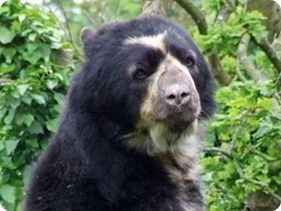 Andean Bear, Tremarctos ornatus (Photo © Krisztián Svábik)
Andean Bear, Tremarctos ornatus (Photo © Krisztián Svábik)
Black-and-gold Howler Monkey, Alouatta caraya (HUNT 2012)
Brown-headed Spider Monkey, Ateles fusciceps (WARD 2012)
Tufted Capuchin, Sapajus apella (WARD 2012)
Bolivian Squirrel Monkey, Saimiri boliviensis
Capybara, Hydrochoerus hydrochaeris (WARD 2012)
Bush Dog, Speothos venaticus
South American Coati, Nasua nasua (CORDULA 2012, HUNT 2012)
Asian Small-clawed Otter, Aonyx cinereus (HUNT 2012, WARD 2012)
South American Tapir, Tapirus terrestris (WARD 2012)
Mallard, Anas platyrhynchos (FISCHBACHER & SCHMID 1999)
Rosy-billed Pochard, Netta peposaca (FISCHBACHER & SCHMID 1999)
LIST OF MIXED-SPECIES EXHIBITS WITH LOCATIONS - URSIDAE
The list shows specific examples of mixed-species exhibits involving at least one ursid species combined with the taxa below, with indication of the institution(s) where they have been tried out
Brown Bear, Ursus arctos
Combined species:
- Brown Bear, Ursus arctos
- Lion, Panthera leo
Institution(s): Shenyang Forest Wild Zoological Garden (China)
Combined species:
- Brown Bear, Ursus arctos
- Eurasian Lynx, Lynx lynx
Institution(s): Zoo Salzburg Hellbrunn (Austria)
Combined species:
- Brown Bear, Ursus arctos lasiotus
- Asiatic Black Bear, Ursus thibetanus japonicus
- Red Fox, Vulpes vulpes japonica
Institution(s): Tama Zoological Park (Tokyo, Japan)
Combined species:
- Brown Bear, Ursus arctos
- Red Fox, Vulpes vulpes
Institution(s): Skansen (Stockholm, Sweden), ZOO Ljubljana (Slovenia), Alpenzoo Innsbruck (Austria), Wildpark Bad Mergentheim (Germany), Heimat-Tierpark Olderdissen (Bielefeld, Germany), Dartmoor Zoo (Sparkwell, United Kingdom), Omaha’s Henry Doorly Zoo & Aquarium (Nebraska, United States of America)
Combined species:
- Brown Bear, Ursus arctos
- Corsac Fox, Vulpes corsac
Institution(s): DierenPark Amersfoort (the Netherlands), Zoo Heidelberg (Germany) (Syrian Brown Bear, Ursus a. syriacus), Tierpark Gotha (Germany) (Syrian Brown Bear, Ursus a. syriacus)
Combined species:
- Brown Bear, Ursus arctos
- Arctic Fox, Alopex lagopus
Institution(s): Skansen (Stockholm, Sweden), Kittenberger Kálmán Növény- és Vadaspark (Veszprém, Hungary), (Kamchatka Brown Bear, Ursus a. beringei), ZOOM Erlebniswelt Gelsenkirchen (Germany) (Kodiak Bear, Ursus a. middendorffi, later Kamchatka Brown Bear, Ursus a. beringei)
Combined species:
- Brown Bear, Ursus arctos
- Golden Jackal, Canis aureus moreotica
Institution(s): Szegedi Vadaspark (Hungary)
Combined species:
- Brown Bear, Ursus arctos
- Grey Wolf, Canis lupus
Institution(s): Dierenrijk (Nuenen, the Netherlands), Ouwehands Dierenpark (Rhenen, the Netherlands), Olmense Zoo (Olmen, Belgium), Pairi Daiza (Brugelette, Belgium), Yaroslavl Zoo (Russia), Alternativer Bärenpark Worbis (Leinefelde-Worbis, Germany), Zoologischer Garten Eberswalde (Germany), Zoologischer Garten Berlin (Germany), Tiergarten Bernburg (Germany), Wildpark Lüneburger Heide (Nindorf-Hanstedt, Germany), Wildpark Poing (Germany), Wisentgehege Springe (Germany), Zoologischer Garten Schwerin (Germany), Juraparc (Le Pont-Vallorbe, Switzerland), Natur- und Tierpark Goldau (Switzerland), Kolmårdens Djurpark (Sweden), Orsa Grönklitt Björnpark (Sweden), Zoo Tábor (Czech Republic), ZOO Ljubjana (Slovenia), Kittenberger Kálmán Növény- és Vadaspark (Veszprém, Hungary), Budakeszi Vadaspark (Hungary), Szegedi Vadaspark (Hungary), Medveotthon (Veresegyház, Hungary), Jászberényi Állat- és Növénykert (Hungary), Grouse Mountain Wildlife Refuge (Vancouver, Canada)
Combined species:
- Brown Bear, Ursus arctos
- Wolverine, Gulo gulo
Institution(s): Tierpark Dählhölzli (Bern, Switzerland), Skansen (Stockholm, Sweden), Zoo d'Amnéville (France)
 Polar Bear, Ursus maritimus
Polar Bear, Ursus maritimus
Combined species:
- Polar Bear, Ursus maritimus
- Arctic Fox, Alopex lagopus
Institution(s): Omaha’s Henry Doorly Zoo (Nebraska, United States of America), Zoo Duisburg (Germany)
Combined species:
- Ursus maritimus x Ursus arctos (Polar Bear x Brown Bear hybrid)
- Silver Fox, Vulpes vulpes var. argentata
Institution(s): Zoo Osnabrück (Germany)
 American Black Bear, Ursus americanus
American Black Bear, Ursus americanus
Combined species:
- American Black Bear, Ursus americanus
- Rhesus Monkey, Macaca mulatta
- Guinea Baboon, Papio papio
Institution(s): Wild Wilderness Drive-Through Safari (Gentry, Arizona, United States of America)
Combined species:
- American Black Bear, Ursus americanus
- Northern Plains Grey Langur, Semnopithecus entellus
unknown institution
Combined species:
- American Black Bear, Ursus americanus
- Hamadryas Baboon, Papio hamadryas
- Kulan, Equus hemionus kulan
- Bactrian Camel, Camelus bactrianus
- Aoudad, Ammotragus lervia
- Ostrich, Struthio camelus
Institution(s): Serengeti Park Hodenhagen (Germany)
Combined species:
- American Black Bear, Ursus americanus
- Lion, Panthera leo
- Tiger, Panthera tigris
Institution(s): Noah’s Ark Animal Sanctuary (Locust Grove, Georgia, United States of America)
Combined species:
- American Black Bear, Ursus americanus
- Puma, Puma concolor
- Grey Wolf, Canis lupus
Institution(s): Out of Africa Wildlife Park (Camp Verde, Arizona, United States of America)
Combined species:
- American Black Bear, Ursus americanus
- Red Fox, Vulpes vulpes
Institution(s): Topeka Zoo (Kansas, United States of America), Turtle Back Zoo (West Orange, New Jersey, United States of America), California Living Museum (Bakersfield, California, United States of America), Oklahoma City Zoo (Oklahoma, United States of America)
Combined species:
- American Black Bear, Ursus americanus
- Grey Fox, Urocyon cinereoargenteus
Institution(s): Arizona-Sonora Desert Museum (Tucson, Arizona, United States of America)
Combined species:
- American Black Bear, Ursus americanus
- Arctic Fox, Alopex lagopus
Institution(s): Dierenpark Zie-ZOO (Volkel, the Netherlands)
Combined species:
- American Black Bear, Ursus americanus
- Grey Wolf, Canis lupus
Institution(s): Ree Park – Ebeltoft Safari (Denmark), Woburn Safari Park (Milton Keynes, United Kingdom), ZOO Olomouc (Czech Republic) (Arctic Wolf, Canis l. arctos), Zoo Tábor (Czech Republic), Olympic Game Farm (Sequim, Washington, United States of America), Greater Vancouver Zoo (Aldergrove, British Columbia, Canada)
Combined species:
- American Black Bear, Ursus americanus
- American Bison, Bison bison
Institution(s): Safari de Peaugres (France)
Combined species:
- American Black Bear, Ursus americanus
- American Bison, Bison bison
- Black-tailed Prairie Dog, Cynomys ludovicianus
Institution(s): Ree Park – Ebeltoft Safari (Denmark)
Combined species:
- American Black Bear, Ursus americanus
- Grey Wolf, Canis lupus
- Black-tailed Prairie Dog, Cynomys ludovicianus
- Moose, Alces americanus
- Wapiti, Cervus canadensis
- White-tailed Deer, Odocoileus virginianus
- Reindeer, Rangifer tarandus
- Muskox, Ovibos moschatus
- Mountain Goat, Oreamnos americanus
- Bighorn Sheep, Ovis canadensis
- American Bison, Bison bison
Institution(s): Zoo sauvage de Saint-Félicien (Quebec, Canada)
Combined species:
- American Black Bear, Ursus americanus
- Collared Peccary, Pecari tajacu
- White-tailed Deer, Odocoileus virginianus sinaloae
- American White Pelican, Pelecanus erythrorhynchos
- Canada Goose, Branta canadensis
- Mallard, Anas platyrhynchos
- Mexican Duck, Anas diazi
- Coot, Fulica sp.
- Wild Turkey, Meleagris gallopavo
Institution(s): Africam Safari (Puebla, Mexico)
Asiatic Black Bear, Ursus thibetanus
Combined species:
- Asiatic Black Bear, Ursus thibetanus
- Celebes Crested Macaque, Macaca nigra
Institution(s): Dudley Zoological Gardens (United Kingdom)
Combined species:
- Asiatic Black Bear, Ursus thibetanus
- Northern Plains Grey Langur, Semnopithecus entellus
Institution(s): Zoologická zahrada Ostrava (Czech Republic)
Combined species:
- Asiatic Black Bear, Ursus thibetanus
- Lion, Panthera leo
Institution(s): Khao Kheow Forest & Wildlife Park (Chon Buri, Thailand)
Combined species:
- Asiatic Black Bear, Ursus thibetanus japonicus
- Masked Palm Civet, Paguma larvata
Institution(s): Ueno Zoological Gardens (Tokyo, Japan)
Combined species:
- Asiatic Black Bear, Ursus thibetanus japonicus
- Brown Bear, Ursus arctos lasiotus
- Red Fox, Vulpes vulpes japonica
Institution(s): Tama Zoological Park (Tokyo, Japan)
Combined species:
- Asiatic Black Bear, Ursus thibetanus
- Corsac Fox, Vulpes corsac
Institution(s): Dierenrijk (Nuenen, the Netherlands)
Combined species:
- Asiatic Black Bear, Ursus thibetanus
- Corsac Fox, Vulpes corsac
- Crested Porcupine, Hystrix cristata
Institution(s): DierenPark Amersfoort (the Netherlands)
Combined species:
- Asiatic Black Bear, Ursus thibetanus
- Grey Wolf, Canis lupus
Institution(s): Safari Park Gelendzhik (Russia)
Combined species:
- Asiatic Black Bear, Ursus thibetanus
- Common Snapping Turtle, Chelydra serpentina
Institution(s): Nagyerdei Kultúrpark (Debrecen, Hungary)
Sloth Bear, Melursus ursinus
Combined species:
- Sloth Bear, Melursus ursinus
- Northern Plains Grey Langur, Semnopithecus entellus
- Reeves’ Muntjac, Muntiacus reevesi
- Indian Peafowl, Pavo cristatus
Institution(s): ZSL London Zoo (United Kingdom)
Combined species:
- Sloth Bear, Melursus ursinus
- Rhesus Monkey, Macaca mulatta
Institution(s): Zoo Leipzig (Germany), Wildlife SOS (Agra, India)
Combined species:
- Sloth Bear, Melursus ursinus
- Stump-tailed Macaque, Macaca arctoides
Institution(s): Tierpark Chemnitz (Germany)
Combined species:
- Sloth Bear, Melursus ursinus
- Stump-tailed Macaque, Macaca arctoides
- Rhesus Monkey, Macaca mulatta
Institution(s): Safaripark Beekse Bergen (Hilvarenbeek, the Netherlands)
Combined species:
- Sloth Bear, Melursus ursinus
- Corsac Fox, Vulpes corsac
- Asian Small-clawed Otter, Aonyx cinereus
Institution(s): Safaripark Beekse Bergen (Hilvarenbeek, the Netherlands)
Combined species:
- Sloth Bear, Melursus ursinus
- African Wolf, Canis anthus, two subspecies, Egyptian Wolf, Canis a. lupaster and Somali Wolf, Canis a. riparius
Institution(s): NaturZoo Rheine (Germany)
Combined species:
- Sloth Bear, Melursus ursinus
- Golden Jackal, Canis aureus moreotica
Institution(s): NaturZoo Rheine (Germany)
Sun Bear, Helarctos malayanus
Combined species:
- Sun Bear, Helarctos malayanus
- Binturong, Arctictis binturong
Institution(s): Espace Zoologique Saint-Martin la Plaine (France), Koninklijke Burgers' Zoo (Arnhem, the Netherlands), Chester Zoo (United Kingdom)
Combined species:
- Sun Bear, Helarctos malayanus
- Dhole, Cuon alpinus
Institution(s): ZooParc de Trégomeur (France)
Combined species:
- Sun Bear, Helarctos malayanus
- South American Coati, Nasua nasua
Institution(s): Zoo Aquarium de Madrid (Spain)
 Andean Bear, Tremarctos ornatus
Andean Bear, Tremarctos ornatus
Combined species:
- Andean Bear, Tremarctos ornatus
- Black-and-gold Howler Monkey, Alouatta caraya
Institution(s): Zoo Frankfurt (Germany)
Combined species:
- Andean Bear, Tremarctos ornatus
- Bolivian Squirrel Monkey, Saimiri boliviensis
Institution(s): ZOO Antwerpen (Belgium), Bioparc de Doué-la-Fontaine (France)
Combined species:
- Andean Bear, Tremarctos ornatus
- Brown-headed Spider Monkey, Ateles fusciceps
- Tufted Capuchin, Sapajus apella
- Capybara, Hydrochoerus hydrochaeris
- Asian Small-clawed Otter, Aonyx cinereus
- South American Tapir, Tapirus terrestris
Institution(s): South Lakes Safari Zoo (Lindal-in-Furness, United Kingdom)
Combined species:
- Andean Bear, Tremarctos ornatus
- Black-and-gold Howler Monkey, Alouatta caraya
- South American Coati, Nasua nasua
- Asian Small-clawed Otter, Aonyx cinereus
Institution(s): Jersey Zoo (Trinity, Channel Islands)
Combined species:
- Andean Bear, Tremarctos ornatus
- Bush Dog, Speothos venaticus
Institution(s): Zoo Frankfurt (Germany)
Combined species:
- Andean Bear, Tremarctos ornatus
- South American Coati, Nasua nasua
Institution(s): Los Angeles Zoo (California, United States of America), Racine Zoo (Wisconsin, United States of America), ZOO Antwerpen (Belgium), ARTIS Amsterdam Royal Zoo (the Netherlands), Chester Zoo (United Kingdom), Port Lympne Wild Animal Park (United Kingdom), Noah’s Ark Zoo Farm (Wraxall, United Kingdom), Zoo Zürich (Switzerland), Zoo Aquarium de Madrid (Spain), Zoo de Pont Scorff (France)
Combined species:
- Andean Bear, Tremarctos ornatus
- Mallard, Anas platyrhynchos
- Rosy-billed Pochard, Netta peposaca
Institution(s): Zoo Zürich (Switzerland)
SUMMARIZE THE EXPERIENCES
According to the EEP Ursid Husbandry Guidelines for the sake of education, creating awareness and the welfare of the bear species it is recommended to plan a mixed species exhibit, whenever possible. It is of course important to determine the main purpose of the exhibit before deciding which species. From an educational point of view the institution might choose a species that occurs in the natural habitat of the bear species. If the main drive is the welfare of the bears you might choose another species, that can be kept together with the bear species. Obviously, the welfare of the non-bear species should also be considered. The weaker species should always have the possibility to retreat to a sufficiently spacious area. Appropriate introduction methods and presence of separation facilities are essential (KOLTER et al. 1998).
Bears with bears (Photo © Erlebnis-Zoo Hannover)
From the historical point of view the first cohabitations with big carnivorans in zoological gardens are connected to exhibitry of different bear species kept together. As a result of that the Zoological Society of London reported the birth of hybrid bears in the middle of the 19th century. Several European institutions, like Zoo Halle, Zoo Osnabrück and Erlebnis-Zoo Hannover have experience of keeping different bears species within the same enclosure.
I would like to add a bit more information from Hannover in reference to keeping different ursids together. The animal dealer Herman Ruhe was the owner of Zoo Hannover (1932 - 1972). In this time it was common that different bear species lived together in one enclosure. Usually the bears came to Hannover at the age of 1 ½ - 2 years and stayed only some weeks or month at the zoo. After that they were sold to other zoos or circuses. After the II. World War Ruhe started with a new mixed bear group. From 1961 there lived together European Brown Bears (1.2), Syrian Brown Bear (0.0.1), Asiatic Black Bears (1.3), Sloth Bears (2.0), Polar Bears (2.3) and Kodiak Bears (1.1). In 1962 and 1963 one of the Asiatic Black Bear females gave birth to two species hybrids (Ursus maritimus x Ursus thibetanus), but all offspring died. The first bears which left this enclosure were the Sloth Bears as they were no more integrable into the group. After that both Kodiak Bears were taken away at the age of 2 ½ years because the animals were too big for the exhibit. The other bears lived together for 6 years and in 1967 all of them left Hannover. 1967 Hannover got a group of 6 month old bears: European Brown Bears (1.2), American Black Bears (1.2), Polar Bears (1.3), Asiatic Black Bears (2.2) and Sloth Bears (0.0.2). In October 1967 the Sloth Bears left Hannover and were given to Montevideo Zoo. In 1968 the mixture group dissolved because all the Polar Bears were sold to other zoos in Germany. The next mixture of bear collection were established in 1971. The institution kept from 1971 till 1981 four bear species together in a 725 m² big enclosure (384 m² landscape, 341 m² water pond). The species were combined: European Brown Bears (1.3) (till 2007/ last female died), American Black Bears (1.3) (till 1996/ last female died), Asiatic Black Bears (1.3) (till 1981/ 0,3 gave away to another zoo), Polar Bears (1.2) (till 2004/ last female died). In this time 23 Brown Bears were born. 7 young Brown Bears had been given to other institution. The Zoo had four Polar bear births and two of these births were species mixture (Ursus maritimus x Ursus arctos). Both young hybrids bears were born in 1976. One of the young mixture bear died 4 days after birth, the other offspring died 17 days after birth. One of the young Polar Bear lived for 3 days, the other birth was a stillbirth. All the Polar bears were born in 1985. In 1977 one Brown Bear female died after an attack from the other bears. In 1981 started incompatibleness between the Asiatic Black Bears and the other bears. For that reason all Asiatic Black Bears were given to other institutions. From 1981 till 1997 (the last American Black Bear died in 1997) the institution had no keeping problems with the three species. From 1997 till 2004 (the last Polar Bear died) Brown Bears and Polar Bears lived together without problems. According to MÜLLER-SCHILLING the bears did not show any signs of stereotypes in their behaviour. That is the positive issue of this mixture bear collection. The European Brown Bears were the dominat species in this mixture group. The Polar bear male showed dominant behaviour only during mating season (MÜLLER-SCHILLING 2012, pers. comm.).
Zoo Osnabrück has been keeping one male Polar Bear with one female Brown Bear together without hyridisation since 1980. After all the hybridisation happened and two viable hybrid speciemens were born in 2004.
Polar Bear x European Brown Bear hybrid (Ursus maritimus x Ursus arctos arctos)
Zoo Osnabrück, Germany
Photo © Ben Gilbert
Births of hybrid bears were reported with several occasions all over the world. The Tama Zoological Garden in Japan noted down hybridisation of Sloth Bear x Sun Bear and a mixture of Sloth Bear x Asiatic Black Bear. Currently all over Asia there are many zoological institutions keeping Asiatic Black Bears and Sun Bears together, like Hlawga Wildlife Park in Myanmar and Chimelong Safari Park in China just to name a few.
As the hybridisation of bears and the mixed-species exhibits are only tangentially related to each other and the first one is not the main subject here I would like to add no more deatil on that here.
Several bear species, like Brown Bears (Ursus arctos), Polar Bears (Ursus maritimus) and American Black Bears (Ursus americanus) were kept together in Zoo Hannover in the 1930s.
Erlebnis-Zoo Hannover, Germany
Photo © Erlebnis-Zoo Hannover
.jpg)
Brown Bear (Ursus arctos) and Polar Bear (Ursus maritimus) mixed exhibit in Hannover in 2002.
Erlebnis-Zoo Hannover, Germany
Photo © Erlebnis-Zoo Hannover
Brown Bear, Ursus arctos
In reference to a mixed-species exhibit with Brown Bears the International Bear Foundation (IBF) recommends the following species: Grey Wolf (Canis lupus), Red Fox (Vulpes vulpes), Arctic Fox (Alopex lagopus), Eurasian Lynx (Lynx lynx) and Eurasian Badger (Meles meles).
The most frequent association is the Brown Bear & Grey Wolf coexistence which have been tried out in many institutions. Some accidents have also been reported: in one occasion a bear cub was killed by full-grown wolves as it was strolled to a bear-proof area, furthermore, another time it happened that a lonely bear was attacked by a pack of wolves. On the contrary Alaskan Tundra Wolf pups were killed by Kodiak Bears in a 3400 m² exhibit in Wildpark Lüneburger Heide (HAMMER 2002, LARSSON 1995). In 2018 four Brown Bear killed a Grey Wolf in front of the visitors in Dierenrijk, the Netherlands.
In one coexistence sometimes bites of wolves against juvenile bears was occured but the aggressions had not been that intensive that the species had to be separated again and the female bear quickly learnt to look after her young. Heavy aggression primarily occured intraspecifically, conflicts between the different species were much more milder. In a wolf & bear community it was reported that one wolf diverted the bear while the others grab the food so the observation of the group-work was a notable part of the behaviour (HAMMER 2002).
In the Bear Forest in Rhenen the Brown Bear & Grey Wolf community has been existing since 1994. In the two hectare size exhibit there is no breeding due to sterilized animals. The wolf-bear interactions seemed to be mostly playful, sometimes agonistic. Especially young bears were more often than others victims of wolf harrassment and were sometimes seriously bitten. There was a problem during feeding: there should have been found some food items which preferred by the wolves but not really by the bears. The problem was solved fed the wolves with rat and muskrat (EIJK 1995).
The mixed exhibits with a wolf & bear association are mostly large, for example the animals have 1,8 hectare in Kolmården and 8 hectare in Orsa Björnpark. It is worth mentioning that Kolmården is one of the first attempts to combine these two carnivorans since 1970. The relatively smaller mixed exhibits – like the 3200 m² size enclosure in Schwerin – usually has an adjoining enclosure for the wolves on their own with access to the bears (HAMMER 2002). In Zoo Schwerin the initial group structure was three female Brown Bears and two male Grey Wolves. The species were habituated to each other for one week, separated by wire mesh. Subsequent association caused no problems. Interspecific interactions occured during feeding sessions: when a female Brown Bear climbed down a tree trunk, a wolf can be observed to pinch her fur (ZIEGLER 2002).
We can read a detailed article about a Syrian Brown Bear & Grey Wolf mixed exhibit in Natur- und Tierpark Goldau in the journal Der Zoologische Garten 80(3): Pp. 93-105. (BAUMANN, A. & WEHRLE, M. 2011).
Brown Bear (Ursus arctos) and Grey Wolf (Canis lupus)
Medveotthon, Veresegyház, Hungary
Photo © Anita Mazács
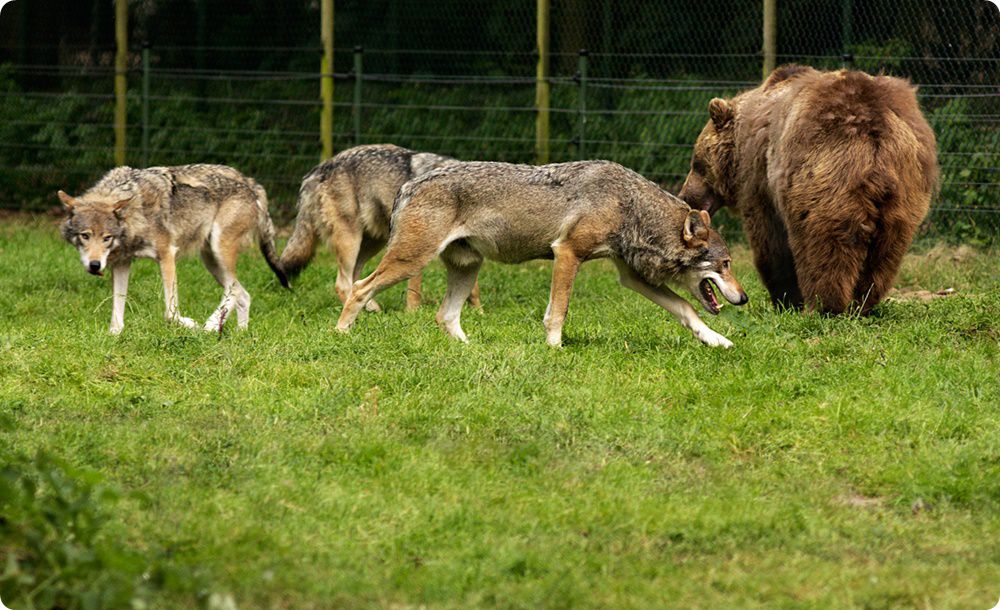
Brown Bear (Ursus arctos) and Grey Wolves (Canis lupus)
Ouwehands Dierenpark, Rhenen, the Netherlands
Photo © Ouwehands Dierenpark
.jpg)
Brown Bear (Ursus arctos) and Grey Wolf (Canis lupus)
Juraparc, Vallorbe, Switzerland
Photo © Klaus Robin
Brown Bear (Ursus arctos) and Grey Wolf (Canis lupus)
Juraparc, Vallorbe, Switzerland
Photos © Juraparc
Syrian Brown Bear (Ursus a. syriacus) and Grey Wolves (Canis lupus)
Natur- und Tierpark Goldau, Switzerland
Photos © Krisztián Svábik
Smaller species of canids were also exhibited together with Brown Bears on several occasions. Szeged Zoo in Hungary kept their Brown Bears together with Golden Jackals (Canis aureus).
ZOOM Erlebniswelt in Gelsenkirchen stopped the coexistence of Arctic Fox (Alopex lagopus) and Kodiak Bear (Ursus a. middendorffi) a few years ago. The park had to learn that it depends very much from the individual specimens: as long as they had an old male bear, the foxes were more or less undisturbed. This male was too slow and not interested in chasing them, and the foxes understood this situation very well. They did not hesitate to approach the bear, stole food just in front of his head and bred succesfully several times. When the old male died the institution got two young male of Kamchatka Brown Bears (Ursus a. beringei) and the situation was totally different. Still the foxes were faster than the bears, but the bears tried to get them, tried to dug them out of the ground and eventually managed to catch one or two. Obviously the foxes were totally stressed, they never bred again and even tried to escape of the enclosure in any way. In the end the institution decided to stop it and leave the bears alone (GÜRTLER 2012, pers. comm.). A Hungarian zoo in Veszprém and the Swedish Skansen also have experiences keeping Brown Bears and Arctic Foxes together.
The Skansen in Stockholm keeps Brown Bears together with Red Foxes (Vulpes vulpes) and it works very well. The only accident which was reported when fox cubs were young and just started to go out from the den the institution has had a few accidents. The park has been keeping the species together for a long time, since the early 1980. The total outdoor area is 3065 m² and indoor for the bears is 113 m². The foxes get an outside area for their own at 44 m² with a “indoor cave”. The bears are able to find something to eat at all time of the day as keepers works a lot with feeding enrichment. The foxes eat a lot of the bears food but they got their own food when the bears are inside the indoor building every night. During the winter their bears are hibernating. More cubs survive inside the bear enclosure comparing to a litter in the nature (ASKELUND 2012, pers. comm.).
An other type of interaction – interspecific play between the juveniles – was also reported, like in Sweden where juvenile bears played with foxes under the supervision of the female bear. The foxes even became that cheeky, that they playfully bit the ears of the adult bears, which took it calmely (CURRY-LINDAHL 1958).
The Alpenzoo Innsbruck in Austria kept their Brown Bears together with Red Foxes in a relatively small, 400 m² exhibit. Foxes became active over night and hided in the tunnels between indoor and outdoor enclosure. Outdoors the young bears inspected the hiding places and the ends of the tunnels, so species were separeted again (HAMMER 2002).
In Omaha’s Henry Doorly Zoo and Aquarium the Red Foxes had to be taken out again from the Grizzly Bear (Ursus a. horribilis) encosure as they always escaped (HAMMER 2002).
.jpg)
Brown Bear (Ursus arctos) and Red Fox (Vulpes vulpes)
Skansen, Stockholm, Sweden
Photo © Skansen
Zoo Heidelberg in Germany keeps their Syrian Brown Bears (Ursus a. syriacus) and Corsac Foxes (Vulpes corsac) together and this coexistence is still working very well for a long time. The first introduction was done in 1981. Initially foxes were habituated to the enclosure without bears being present. Male juvenile foxes often steel food items from bears at close range. Bears subsequently chase foxes over short distances. This challenging behaviour was rarely observed in female foxes. Loss of some infant/juvenile foxes caused by the bears was reported from the early years of this association. Nowadays newborn foxes and parents are kept in the indoor enclosure for approximately 3-4 months. Then they get access to the outdoor enclosure during the nights. Finally they have exclusive access to the outdoor enclosure for one day before the group is (re)associated with the bears. This procedure prevented further losses of young foxes until now (REICHLER-DANIELOWSKI 2012, pers. comm., ZIEGLER 2002).
Syrian Brown Bear (Ursus a. syriacus) and Corsac Fox (Vulpes corsac)
Zoo Heidelberg, Germany
Photos © Allan Galway
.jpg)
Syrian Brown Bear (Ursus a. syriacus) and Corsac Fox (Vulpes corsac)
Zoo Heidelberg, Germany
Photo © Zoo Heidelberg
A lethal accident happened in Zoo Salzburg Hellbrunn, in a 1600 m² sized mixed exhibit with Brown Bears and Eurasian Lynxes (Lynx lynx). One of the two lynxes repeatedly attacked the bear. In one of these attacks the lynx was careless and came into a dead corner of the exhibit from where it was no able to flee from the bear. The other lynx was was stayed undisturbed by the bears. Worth to mention that Wolverines (Gulo gulo), which inhabit the neighbouring enclosure dug themselves through the enclosure for the bears, so sometimes all three species of carnivorans can be observed in the same exhibit (HAMMER 2002).
The Animal Park Bern in Switzerland has a long history of mixing their Brown Bears with Wolverines (Gulo gulo), the first introduction was done in 1993. Initially two old Syrian Brown Bears lived in the 3600 m² sized enclosure and showed no significant interest for the Wolverines. The mustelids had smaller „bear-proof” areas protected by electric fence. In 2004 the situation was totally changed as two young female European Brown Bears arrived and shared the exhibit with the breeding pair of Wolverines and the curious bears showed significant interest for the other species. The electric fence was no more enough to protect the Wolverines in their own territory, so a rised, two meter high platforms and shelters were created for them which was unsafe for the bears due to their bigger body weight. During the female Wolverine was raising cubs the two species were separated. Carcass feeding was also proved to an appropriate behavioural enrichment for both species: at daytime principally the bears owned it but after locked them inside during the night the mustelids have the opportunity to acquired that. The Wolverines ate from the carcass and partially dug it inside the enclosure which was proved to be a good activity for the bears to find it next day. According to dr. Marc ROSSET serious accidents or injuries have not been reported during the cohabitation (ROSSET 2007, 2012, pers. comm.).
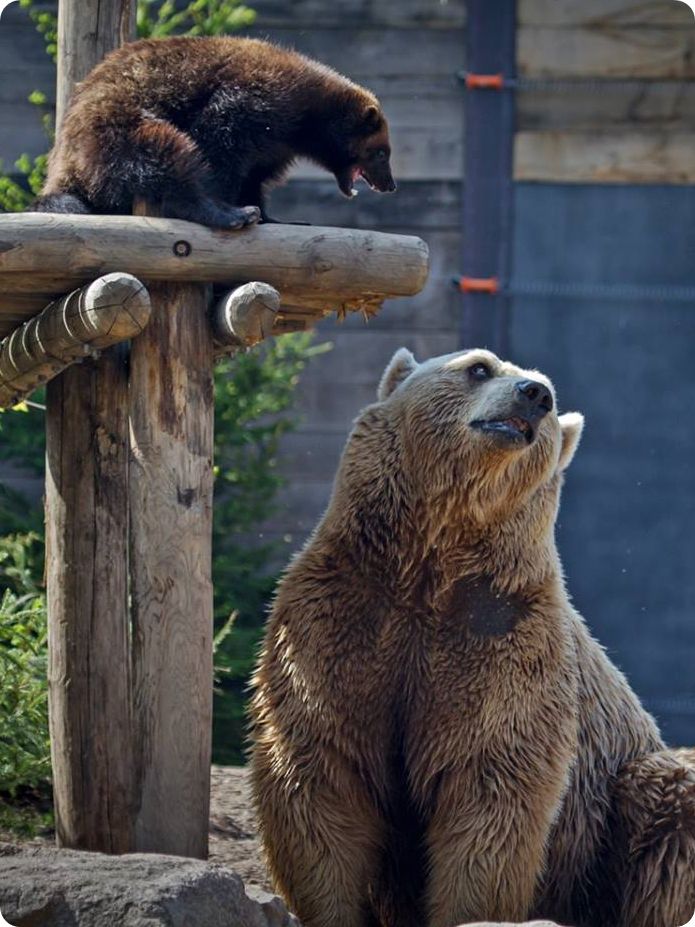
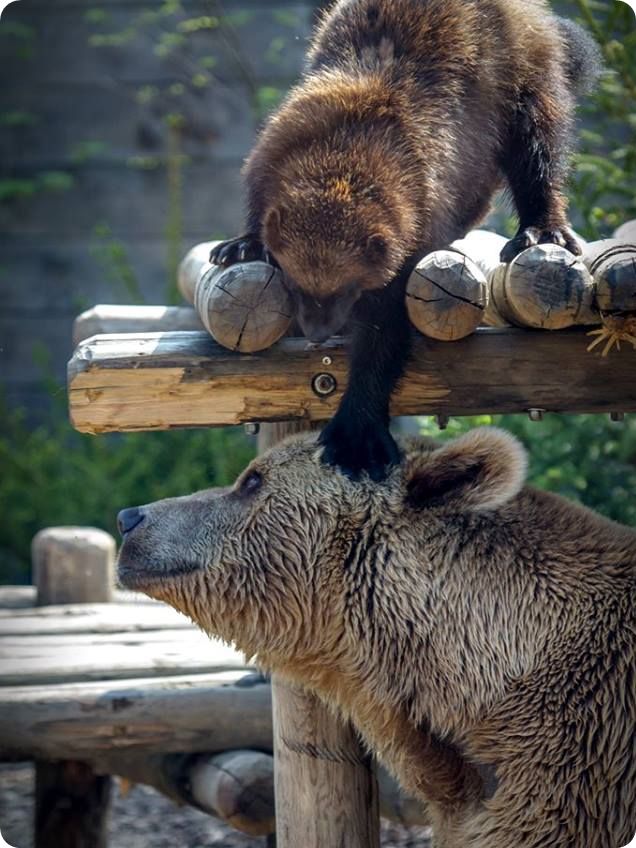
European Brown Bear (Ursus arctos arctos) and Wolverine (Gulo gulo gulo)
Zoo d'Amnéville, France
Photo © Ingrid Klaus
 Polar Bear, Ursus maritimus
Polar Bear, Ursus maritimus
Polar Bears and Arctic Foxes have been combined in a realtively small, 348 m² sized enclosure in Omaha’s Henry Doorly Zoo and Aquarium in Nebraska. Initially foxes were chased by the bears and as long as the bears were young and quick a danger existed that one of the fox was caught by them. The foxes had areas for retreat where they slept and did not seem nervous and also reared young. They habituated quickly the presence of the bears and finally slept in the enclosure part of the bears. Later on one fox was killed as it slept in the non bear-proof area of the exhibit (HAMMER 2002). According to a recommendation it is practical to combine young bears and adult foxes (THOMAS 1968). A former guide from Zoo Duisburg was also mentioning the same combination. Dublin Zoo has also planned this coexistence although it was never realised (MOLLOY 2012, pers. comm.)
According to the protocol of the AZA Bear Tag (2007) – Standardized Animal Care Guidelines: Polar Bear (Ursus maritimus) – it is not recommended to combine Polar Bears with other species (DORMAN & BOURNE 2009).
Worth to mentioning that Zoo Osnabrück keeps their Polar Bear x Brown Bear hybrids together with Silver Foxes.
Polar Bear x European Brown Bear (Ursus maritimus x Ursus arctos arctos) hybrid and Silver Fox (Vulpes vulpes var. argentata) mixed exhibit
Zoo Osnabrück, Germany
Photo © Ben Gilbert
 American Black Bear, Ursus americanus
American Black Bear, Ursus americanus
One of the most complex multi-species exhibit in point of size of the area and number of species is taken place in Zoo sauvage de Saint-Félicien in Quebec, Canada. Their „Natural Trail Park” area is about 185 hectares in there the institution has American Black Bear, Grey Wolf (Canis lupus), Wapiti (Cervus canadensis), Reindeer (Rangifer tarandus), Mooose (Alces americanus), White-tailed Deer (Odocoileus virginianus), Muskox (Ovibos moschatus), American Bison (Bison bison), Black-tailed Prairie Dog (Cynomys ludovicianus) and birds (GAGNON 2012, pers. comm.). According to a former reference (LUBIW-HAZARD 2000) another species, like Bighorn Sheep (Ovis canadensis) and Mountain Goat (Oreamnos americanus) were also exhibited in this area which was about 325 hectares. It has been working since 1972. The animals in the park are well adapted, they breed and behave naturally. In spring bears prey upon White-tailed Deer fawns which helps keeping the herd stable. The institution usually brings the female deer in enclosures for birthing but it is impossible to catch all of them (GAGNON 2012, pers. comm.).
American Black Bear (Ursus americanus) with White-tailed Deer (Odocoileus virginianus) (on the left) and with Wapiti (Cervus canadensis) (on the right)
Zoo sauvage de Saint-Félicien, Quebec, Canada
Photos © Zoo sauvage de Saint-Félicien
In Europe there is also an exemplar of keeping American Black Bears and big herbivores together. Safari Park Peaugres in France has an extended 30 hectar size area for its bears and American Bisons (Bison bison). The bisons are dominant toward the black bears, so the bears never come too close to an adult bison as the bison would charge them. Young bisons are protected by adults. In the past there were some attacks when weak, newborn bisons were attacked by the bears and the adults did not protect them well but nowadays no injuries have been reported. The bisons probably learnt to "manage" the bears. In case of a bison dies of illness or accident, its corpse will be eaten by the bears if the caretakers are not able to manage to take it soon enough (PIGNOREL 2007, DUBOIS 2012, pers. comm.).
An other safari park, Ree Park - Ebeltoft Safari in Denmark also has experince with keeping American Black Bears and American Bisons, furthermore Black-tailed Prairie Dogs (Cynomys ludovicianus) together (JENSEN 2008, pers. comm).
.jpg)
.jpg)
American Black Bear (Ursus americanus) and American Bisons (Bison bison)
Espace au Safari de Peaugres, France
Photos © Arthus Boutin
The Africam Safari Park in Mexico also combined their American Black Bears with big herbivores and several species of birds in a several hectares of land. Originally only the bears have been settled down in the area, after that, in 1995 White-tailed Deer (Odocoileus virginianus sinaloae) added, in 1996 Collared Peccaries (Pecari tajacu) arrived and in 2002 several bird species, primarily waterfowl were introduced to the exhibit. The peccaries are penned separately at night, the bears are also placed in dormitories during the night. When a new bear is introduced, the peccaries and goose are kept in adjacent pens. One occasion an accident has also been reported: one introduced peccary was predated by bears the second day after it was added to exhibit. No other animal has been predated (AZA Ungulate TAGs 2017).
The Serengeti Park Hodenhagen in Germany and the Wild Wilderness Drive-Through Safari in the USA also provides an extended area for their black bears, ungulates and primates.
Another mixed exhibit with bears and cats was taken place in Out of Africa Wildlife Park in Arizona, where two female American Black Bears lived together with two female Cougars (Puma concolor) for about 17 years without serious incidents. Furthermore, a pack of four young Grey Wolves (Canis lupus), two males and two females, lived harmoniously together with the bears and cats for about one year. But as the wolves matured, they became somewhat assertive over one of the Cougars, so the wolves were removed to another habitat. After that the Cougars remained with the bears and currently the ursids are alone (HARRISON, POWELL 2012, pers.comm.).
A rescued American Black Bear, a Lion (Panthera leo) and a Tiger (Panthera tigris) have been living together since their „childhood” at Noah’s Ark Animal Sanctuary.
Several species of canids, like Grey Wolf (Canis lupus), Grey Foy (Urocyon cinereoargenteus), Arctic Fox (Alopex lagopus) and Red Fox (Vulpes vulpes) has also been combined with American Black Bears.
Furthermore, Northern Plains Grey Langurs (Semnopithecus entellus) has also been exhibited together with black bears (AMES 1998).
American Black Bear (Ursus americanus) and Cougar (Puma concolor)
Out of Africa Wildlife Park, Camp Verde, Arizona, United States of America
Photo © Out of Africa Wildlife Park
American Black Bears (Ursus americanus) and Grey Wolves (Canis lupus)
Ree Park –Ebeltoft Safari, Denmark
Photo © Kare Jensen
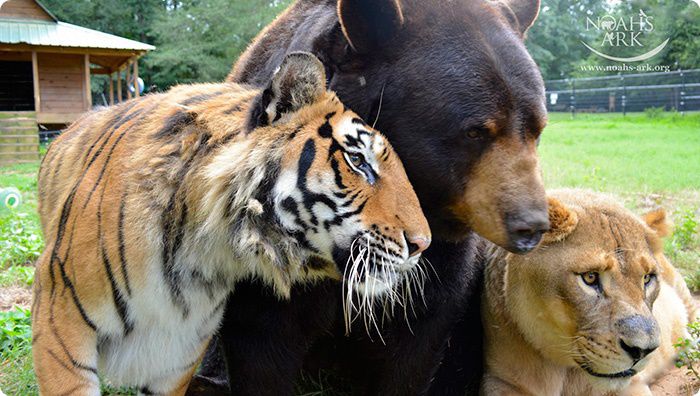
American Black Bear (Ursus americanus), Tiger (Panthera tigris) and Lion (Panthera leo)
Noah’s Ark Animal Sanctuary, Locust Grove, Georgia, United States of America
Photo © Noah’s Ark Animal Sanctuary
Asiatic Black Bear, Ursus thibetanus
A relatively aggressive Asiatic Black Bears has also been managed with other species in zoological institutions. In the 1,4 hectar big natural forest exhibit, called „Chitwan” in Zoo Ostrava we can see a peaceful cohabitation of Asiatic Black Bears with Nothern Plains Grey Langurs (Semnopithecus entellus). Up to the present no accidents were reported. The general approach, as it is recommended to combine young individuals is not valid here as well: the success of this mixed-species exhibit rests on the fact that those bears are elderly specimens and show only a less intensive interest for the primates (ONDRUŠOVÁ 2007, 2012, pers. comm.).
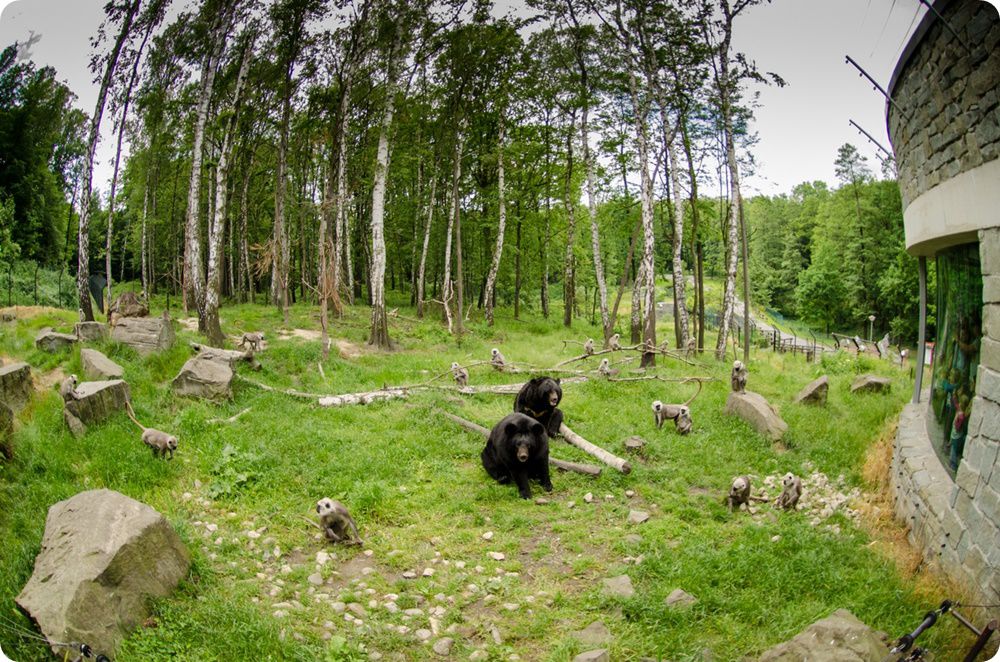
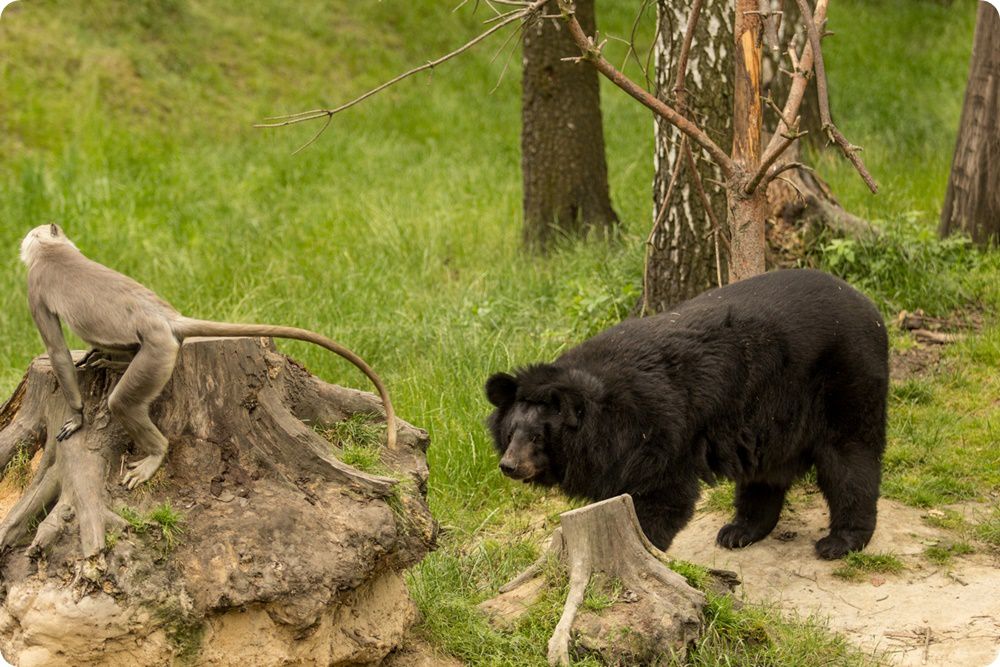
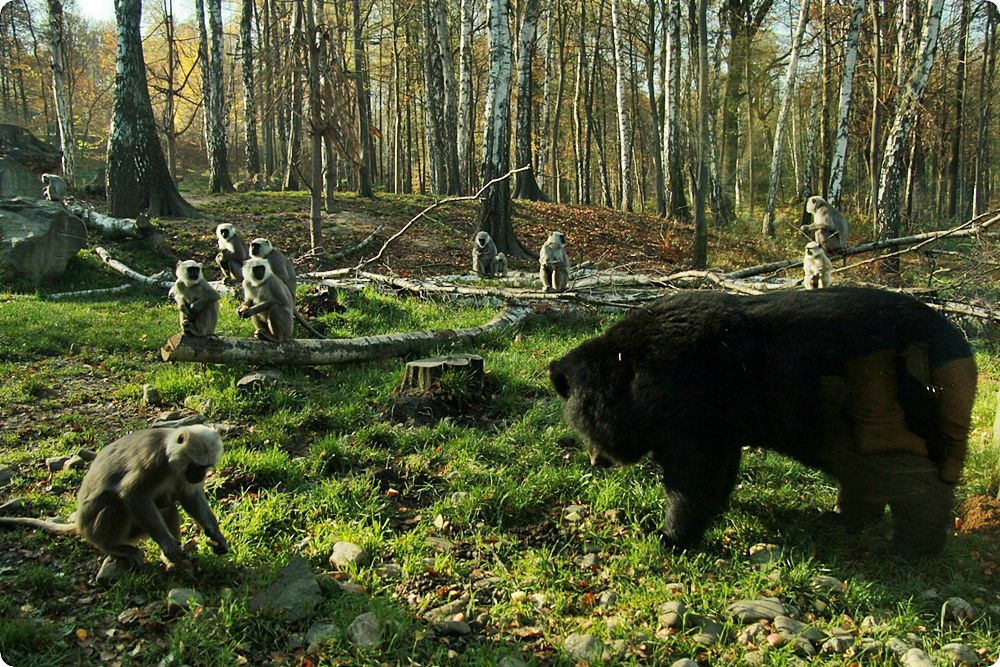
Asiatic Black Bears (Ursus thibetanus) and Northern Plains Grey Langurs (Semnopithecus entellus)
Zoologická zahrada Ostrava, Czech Republic
Photos © Zoologická zahrada Ostrava (above), Krisztián Svábik (below)
In Amersfoort the Asiatic Black Bears cohabited with Corsac Foxes (Vulpes corsac) and Crested Porcupine (Hystrix cristata) in the past. This combination worked quite well without any major problems. The foxes had the opportunity to choose between two enclosures with two different species of bears, e.a. through a tunnel system they could go to the enclosure for the Asiatic Black and to the enclosure for Brown Bears. During the day in 99% of the case they spent their time in the black bear enclosure together with the porcupines as well. The Brown Bears were more active hunters on them than the black bears, so they chosed during the day for the most peaceful option. At night when the Brown Bears were locked up in the resting enclosures, the did not had fear to go to brown´s enclosure. One male Corsac Fox and one female Asiatic Black Bear were sent to Dierenrijk in 2009 and this institution has also continued with this mixed exhibit (DIJKGRAAF 2012, pers. comm.). After that Dierenrijk received a new breeding pair of Asiatic Black Bears from Lisbon Zoo and also a new group of Corsac Fox, one male with three females from other institutions. The animals still coexist, although not without a „learning curve”. The fox from Amersfoort knew how to stay away from the bears, so it kept his distance. The bears lost their interest for the fox. However the 1.3 foxes from Hamerton never learnt how to live together with bears. The foxes were far to curious and approached the bears without any fear. One of the female foxes was killed after three days of introduction. The foxes learnt from this, so after that they kept themselves away from the bears. About two months later the keepers found another fox killed in the inside enclosure. It was killed because tried to stole food from the bears inside, since the inside enclosure only had one enter and access point the fox could not get away in time. After this the staff adjusted the entrance, they added a rubber flap in front of the entrance, heavy enough to make it impossible for the foxes to lift it, but the bears can easily lift the flap to get in (JANSEN 2012, pers. comm.).
Asiatic Black Bear (Ursus thibetanus) and Corsac Foxes (Vulpes corsac)
Dierenpark Amersfoort, the Netherlands
Photo © Dierenpark Amersfoort
Sloth Bear, Melursus ursinus
Sloth Bears have also been managed in a mixed exhibit in several times. London Zoo kept their bears together with Northern Plains Grey Langurs (Semnopithecus entellus), Reeves’ Muntjacs (Muntiacus reevesi) (AMES 1998), as well as with Indian Peafowl (Pavo cristatus) and waterfowl (HETTLER 1998) in a 6000 m² sized Asian exhibit. The initially peaceful coexistence has been ended suddenly when the female bear was raising young. The aggressive behaviour of a female deer towards the bear cub resulted that a female bear killed the muntjac (FITZPATRICK, pers. comm., quoted by DORMAN & BOURNE 2009). Furthermore, after the separation of the deer the peafowl also had to removed to an other facility (HAMMER 2002).
Leipzig gives another example of that Sloth Bears and primates can be kept together successfully. The bears are combined there with Rhesus Monkeys (Macaca mulatta). The initial group structure was 1.2 Sloth Bears and 0.4.1 Rhesus Monkeys, a male macaque added later. The 580 m² sized exhibit surrounded by artificial cliffs and water moat, planted areas initially protected with electric fence. Monkeys were habituated first to the new outdoor enclosure in absence of bears. Then bears were habituated to the new outdoor enclosure and the hot wires. During the first weeks of association, Rhesus Monkeys stayed in the upper levels of the central climbing structures when bears were present. Just a few weeks later monkeys could be observed to move on the ground even when bears were around. While both species move on or near the ground, monkeys show increased vigilance behaviour and keep an appropriate distance to bears. The association is only valid for the outdoor enclosure. At night, bears are kept indoor, while monkeys are free to move in and out (ZIEGLER 2002). The base of the effective socialization of the two species is that the ursids have an adjacent „monkey-proof” enclosure where the females can raise their young calmly. Worth mentioning that the monkeys has also raised young successfully with the presence of the bears. Direct and physical contact can also been observed between the bears and monkeys as young macaques are riding on the back of the bears. A problem was occured only during feeding time when the faster and more agile monkeys could steal the food of the bears (FELGNER 2007, pers. comm.).
Wildlife SOS has the same combination in India.
.jpg)
Sloth Bear (Melursus ursinus) and Rhesus Monkey (Macaca mulatta)
Zoologischer Garten Leipzig, Germany
Photo © Zoologischer Garten Leipzig
Sloth Bear (Melursus ursinus) and Rhesus Monkey (Macaca mulatta) mixed exhibit
Zoologischer Garten Leipzig, Germany
Photo © Zoologischer Garten Leipzig
Sloth Bear (Melursus ursinus) and Rhesus Monkeys (Macaca mulatta)
Wildlife SOS, Agra, India
Photo © Dr. Helmut Mägdefrau
Beekse Bergen Safari Park in the Netherlands has also tried out this combination. Sometimes a „grouped attack” by the monkeys towards the bears can also be observed. In 2006 a lethal accident was reported as one of the bears killed and partly ate an other species of primates, a Stump-tailed Macaque (Macaca arctoides) in front of the visitors (VERSTEEGE 2012, pers. comm.). In the recent past the institution introduced Corsac Foxes (Vulpes corsac) and Asian Small-clawed Otters (Aonyx cinereus) into the new enclosure of their Sloth Bears. The exhibit is not for breeding purposes so male groups were created from each species (VERSTEEGE 2018, pers. comm.).
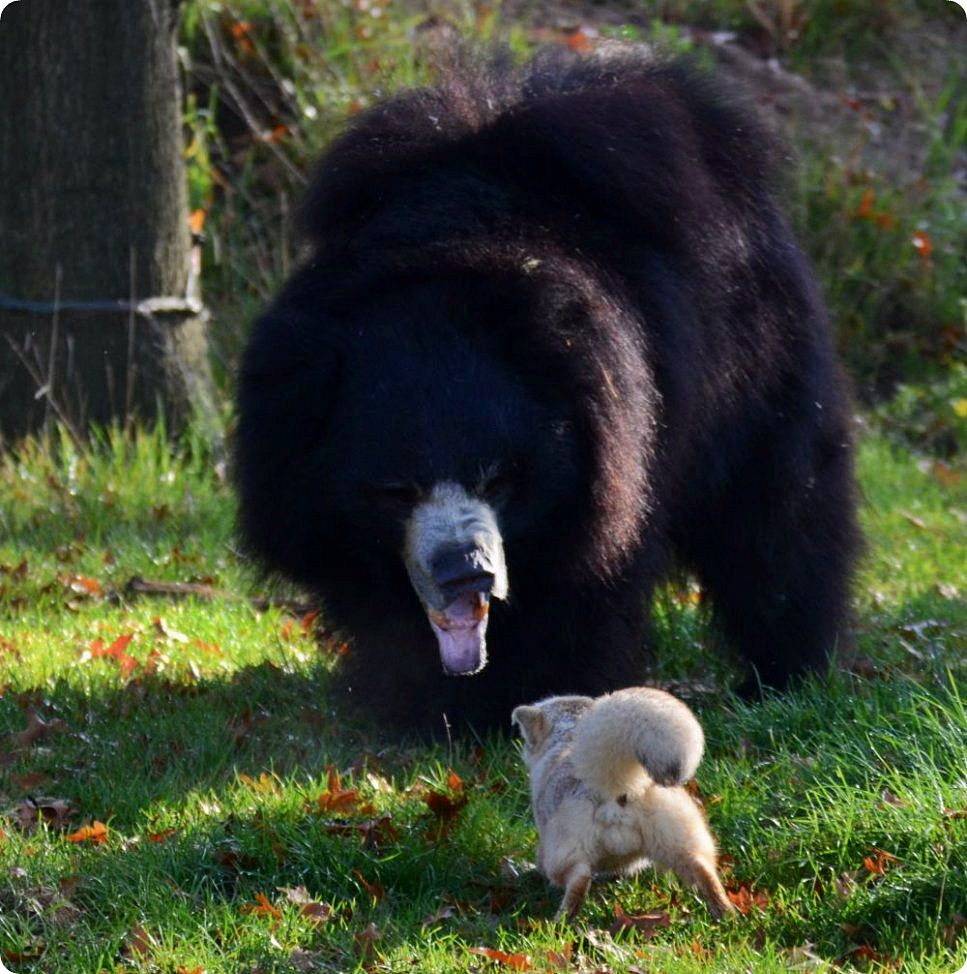
Sloth Bear (Melursus ursinus) and Corsac Fox (Vulpes corsac)
Safaripark Beekse Bergen, Hilvarenbeek, the Netherlands
Photo © Neil Ingram
Sloth Bears (Melursus ursinus) and Corsac Foxes (Vulpes corsac)
Safaripark Beekse Bergen, Hilvarenbeek, the Netherlands
Photo © Örs Görög
NaturZoo Rheine in Germany has a Sloth Bear & Golden Jackal (Canis aureus) mixed exhibit, however, beforehand an African Wolf (Canis anthus, two subspecies, Egyptian Wolf, Canis a. lupaster and Somali Wolf, Canis a. riparius) was kept together with the bears. The relatively big exhibit is about 5300 m² and it was built in 2009. We can read a detailed article about this cohabitation in the journal Der Zoologische Garten 80 (2011) Pp. 1-28. (JOHANN 2011).
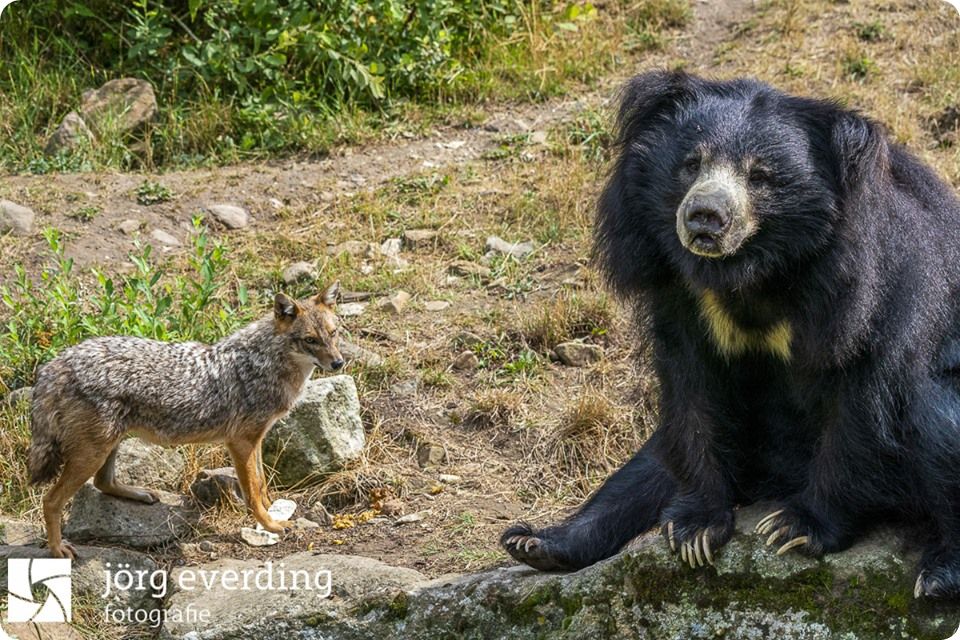
Sloth Bear (Melursus ursinus) and Golden Jackal (Canis aureus)
NaturZoo Rheine, Germany
Photo © Jörg Everding
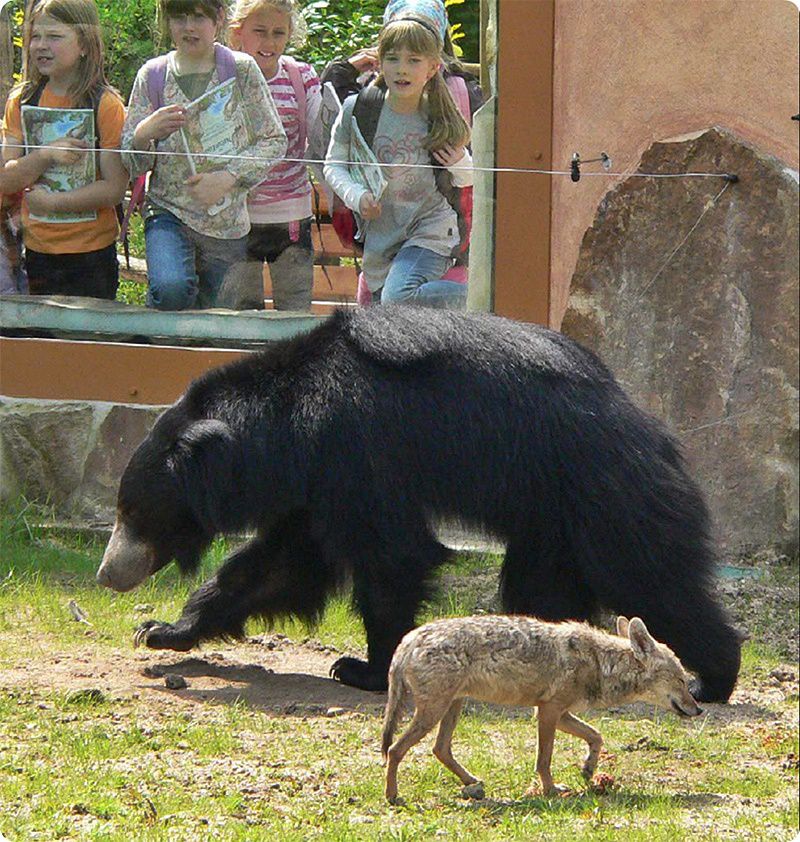
Indian Sloth Bear (Melursus ursinus ursinus) and European Golden Jackal (Canis aureus moreotica)
NaturZoo Rheine, Germany
Photo © NaturZoo Rheine
Sun Bear, Helarctos malayanus
Sun Bears combined with Binturongs (Arctictis binturong) in three institutions in France, the Netherlands and United Kingdom.
At Zoo Saint-Martin-la-Plaine in France the Sun Bear and Binturong coexistence was not planned: at first one Binturong found a way to get into the neighbouring bear enclosure and was used afterwards to feed together with them without any aggression (HAMMER 2002). Afterwards a female Sun Bear was born there and it has lived with Binturongs since its birth date. Later on the institution received a male bear and the introduction with the Binturongs was not a problem, although the male bear was separated during the night because it was a little aggressive during feeding. There were two connected outdoor enclosures and all the animals were fed together outside without problem. The size of the area is around 500 m². One lethal accident was also reported. A newly arrived male Binturong was really bad-tempered and was moaning a lot against the other Binturongs and bears. One day it was in the indoor enclosure with the male bear where a fight started resulted in a bear has killed and partially ate the Binturong (GERARD 2012, pers. comm.).
Sun Bear (Helarctos malayanus) and Binturong (Arctictis binturong)
Espace Zoologique de Saint-Martin-la-Plaine, France
Photos © Espace Zoologique de Saint-Martin-la-Plaine
In Arnhem Sun Bears are still living together with Binturongs in the Burgers’ Rimba exhibit which cohabitation is going well. The two species were first introduced to each other in 2009. The colleagues thought that the bears would chase after the Binturongs and dominate them but that was not the case. The Binturongs arrived from the abovementioned French institution so have had previous experiences with the presence of the bears. The viverrids are also dominant during feeding therefore the main food is fed separately in the indoor enclosures to prevent competititon. The rest of the food is scattered in the outdoor enclosure – which is around 1300 m² – also for enrichment. The bears are together with the Binturongs in the outdoor enclosure and sometimes in the indoor enclosure visible for the public. During the night the Binturongs are in their own pens. The male bear is separated from the females and has two night pens to himself. The female bears have the opportunity to go in all the other inside enclosures including enclosure visible for public and breeding pens. Since some time the colleagues noticed wounds on the base of the tails of the Binturongs. According to the veterinarian this is probably caused by the bears. The keepers think the bears bite them as the Binturongs go into their night enclosure when their tale sticks out (VAN de PUT 2012, pers. comm.).
In the United Kingdom Chester Zoo has the same species combination.
Sun Bear (Helarctos malayanus) and Binturong (Arctictis binturong) mixed exhibit
Burgers’ Zoo, Arnhem, the Netherlands
Photo © Krisztián Svábik
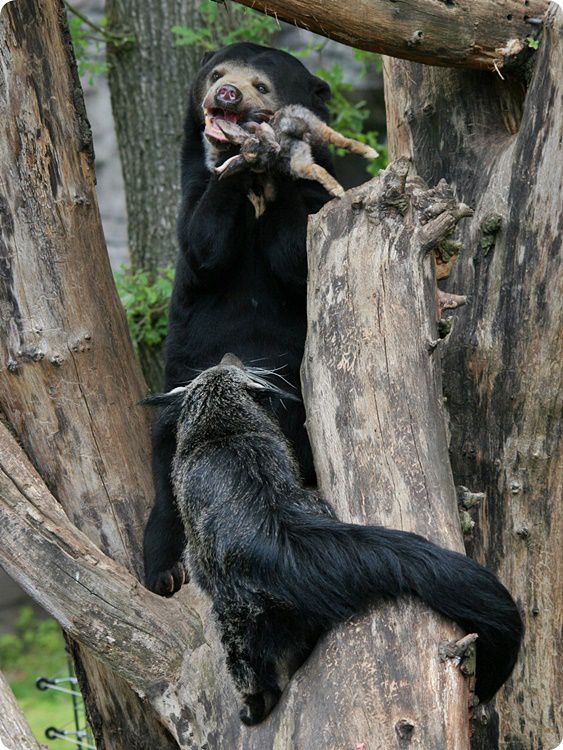
Sun Bear (Helarctos malayanus) and Binturong (Arctictis binturong)
Koninklijke Burgers’ Zoo, Arnhem, the Netherlands
Photos © Krisztián Svábik and Eelke Denekamp
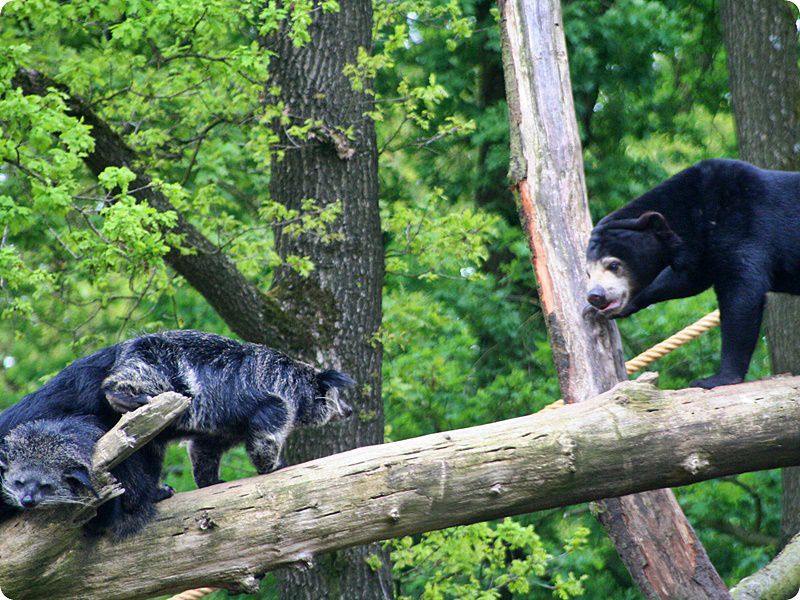
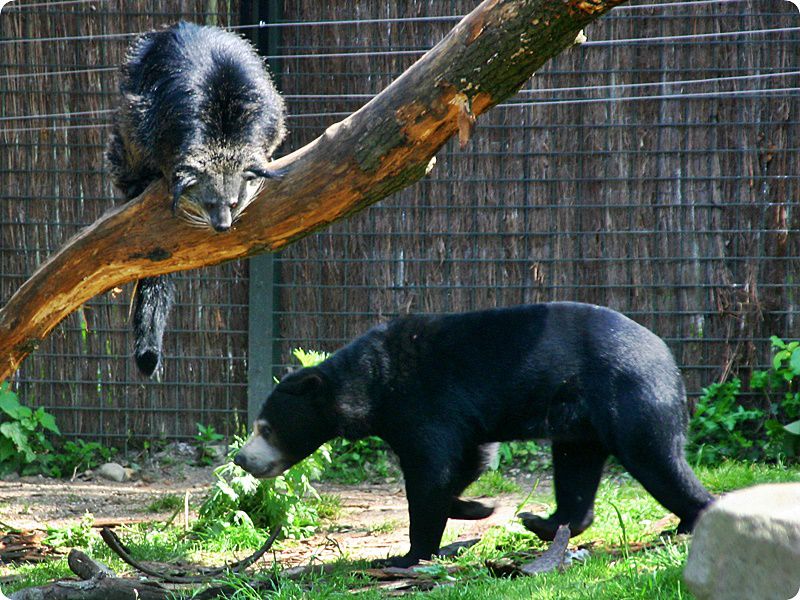
Sun Bear (Helarctos malayanus) and Binturong (Arctictis binturong)
Koninklijke Burgers’ Zoo, Arnhem, the Netherlands
Photos © Christiaan Luttenberg and Jan Vermeer
.jpg)
Sun Bears (Helarctos malayanus) and Binturongs (Arctictis binturong)
Burgers’ Zoo, Arnhem, the Netherlands
Photo © Theo Kruse
Surprisingly Dholes (Cuon alpinus) has also been exhibited together with Sun Bears in a french institution where the canids had their own bear-proof area.
 Andean Bear, Tremarctos ornatus
Andean Bear, Tremarctos ornatus
Andean Bears have been combined with other species in several times. According to World Association of Zoos and Aquariums (WAZA) the species can be kept together with Coatis (Nasua spp.) and primates (WAZA 2007).
The Andean Bear & South American Coati (Nasua nasua) combination is one of the most frequent association with the species which has been tried out in many zoological institutions. It was reported from Los Angeles Zoo that the two species have had offspring in the same time during exhibited together (DEE 1988).
Madrid Zoo does not have any more the combination of South American Coati with Sun Bear and Andean Bear as the institution stopped keeping coatis, so, when the last one died due to its old age this combination stopped, but this coexistence was quite good, the zoo had not recognized any problem at all between them, the coatis had spaces free of bears but they did not really need them (DELCLAUX 2018, pers. comm.).
In Zoo Zürich Andean Bears and South American Coatis live together. Before this combination the bears were exhibited together with Mallards (Anas platyrhynchos) and Rosy-billed Pochard (Netta peposaca) (FISCHBACHER & SCHMID 1999). The institution has no problems with the bear and coati coexistence and it still works very well. The Sangay Cloud Forest exhibit opened in 1995 and consists of three different enclosure part which makes it possible for the coatis raising their youngs calmly. When a new male coati arrived it took only a few weeks to get him used to the enclosure and for the bears. There are some pipes in the enclosure that form tunnels below the ground so the coatis can pass through but the bears cannot. Sometimes the two species are foraging very close to each other. The institution even had a quite old female coati that moves very wiggled because of an old injury which was not caused by the bears. She was not very fast but never had problems of being chased. Just when the coatis were rearing pups the staff make sure that they did not share the same enclosure (GALEFFI 2012, pers. comm.). An old female Andean Bear is still living together with the coatis (LODDENKEMPER 2018, pers. comm.)
Andean Bear (Tremarctos ornatus) and South American Coati (Nasua nasua)
Zoo Zürich, Switzerland
Photo © Krisztián Svábik

Andean Bear (Tremarctos ornatus) and South American Coatis (Nasua nasua)
ZOO Antwerpen, Belgium
Photo © www.zoochat.com
.jpg)
Andean Bear (Tremarctos ornatus) and South American Coati (Nasua nasua) mixed exhibit
Chester Zoo, United Kingdom
Photo © Krisztián Svábik
Some years beforehand Jersey Zoo has mixed their female group of South American Coatis with a breeding pair of Andean Bear and also with a big group of Black-and-gold Howler Monkeys (Alouatta caraya). Before that Asian Small-clawed Otters (Aonyx cinereus) also housed with these species (COWAN et al. 1999). The institution has had very few problems with these species mixing together, although there was one occurrence where an otter died from being hit by the bear (the otter was trying to steal the bears food) but this happened in the early stages of the mixed exhibit. The total outside area of the enclosure is 1700 m² with the inside building partially buried in the middle. The outside enclosure is designed so that it can either be used as one large area or be split into two separate areas using gates at both the front and back of the enclosure. There is also a most which surround the outside enclosure which the bears enjoy swimming in and was also utilised by the otters when they were present in the enclosure. The outside has been designed to accommodate all of our animals with large tree trunks for the bears to climb and smaller trees and rope for the monkeys and coatis to use. The inside enclosure is split into six dens, each den has both a large sliding door for the bears and a smaller door with a tunnel exit for the coatis and otter when they were mixed. The howlers shut into their den in overnight as a precaution but the coatis have outside access continuously. The bears get most of their feeds outside on the west side of the enclosure (if weather is very bad they will receive their food inside), although do get some scatter on the east side for enrichment. Coatis receive their feeds on the east side of the enclosure (again inside in their den if the weather is bad), they do always get fed their protein inside so that we can check them closely once a day. Howler monkeys have their main feed at the end of the day when they are shut into their den; is summer they spend a large portion of their day outside browsing on the trees, during the winter they share the inside with the coatis and get their leafy greens inside. The coatis and howlers are fairly tolerant of each other and can be seen feeding near each other. They do get the occasional quarrel, but this is usually the juvenile howler monkeys annoying the coatis like poking and jumping on them. They have had several occurrences now of the female howler monkeys giving birth whilst with the coatis and all has been well. The coatis and the howlers are quite watchful of the bears and often retreat to the trees when the bears get too close. Usually if the bears show too much interest in the howler monkeys the group start to display and the bears loose interest and walk off. The most interaction they had was between the bears and the otter, the female otter was especially naughty and loved to sneak up behind the bears and bite their bottom or ankles. Luckily she was too quick for them to retaliate and just ran away. She could also be seen during the winter to sleep inside with the bears quite close (HUNT 2012, pers. comm.).
.jpg)
.jpg) Andean Bear (Tremarctos ornatus) and Asian Small-clawed Otter (Aonyx cinereus) (on the left) and Black-and-gold Howler Monkey (Alouatta caraya) (on the right)
Andean Bear (Tremarctos ornatus) and Asian Small-clawed Otter (Aonyx cinereus) (on the left) and Black-and-gold Howler Monkey (Alouatta caraya) (on the right)
Jersey Zoo, Trinity, Channel Islands
Photos © Jersey Zoo and Tim Preston
Andean Bears have been combined with other primates, like Bolivian Squirrel Monkeys (Saimiri boliviensis boliviensis) in Zoo Antwerpen and Bioparc de Doué-la-Fontaine. Frankfurt Zoo has also tried out the combination with Black-and-gold Howler Monkeys.
Andean Bear (Tremarctos ornatus) and Bolivian Squirrel Monkeys (Saimiri boliviensis boliviensis)
ZOO Antwerpen, Belgium
Photo © Krisztián Svábik
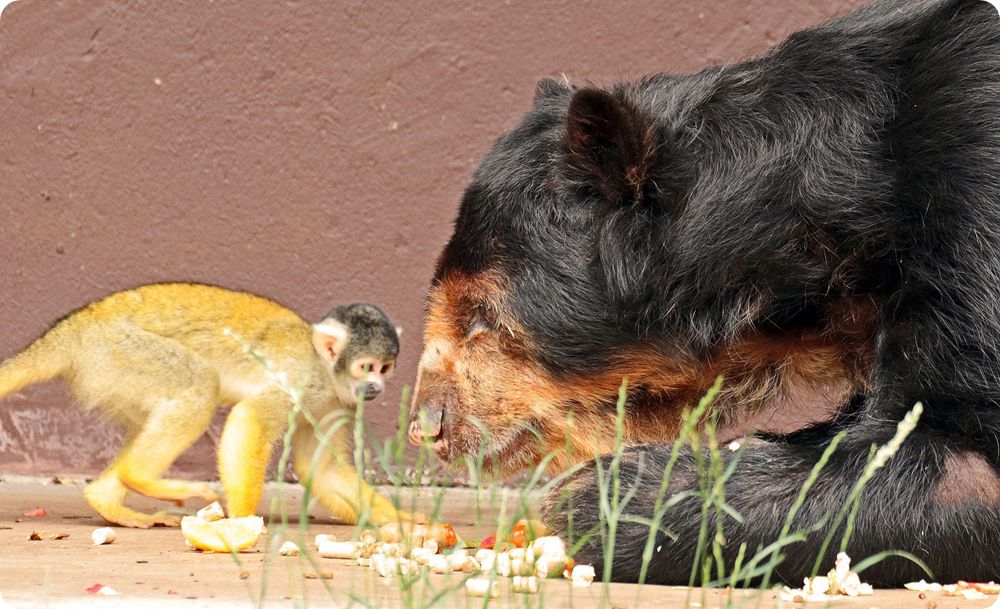
Andean Bear (Tremarctos ornatus) and Bolivian Squirrel Monkey (Saimiri boliviensis boliviensis)
ZOO Antwerpen, Belgium
Photo © Tom van Deuren
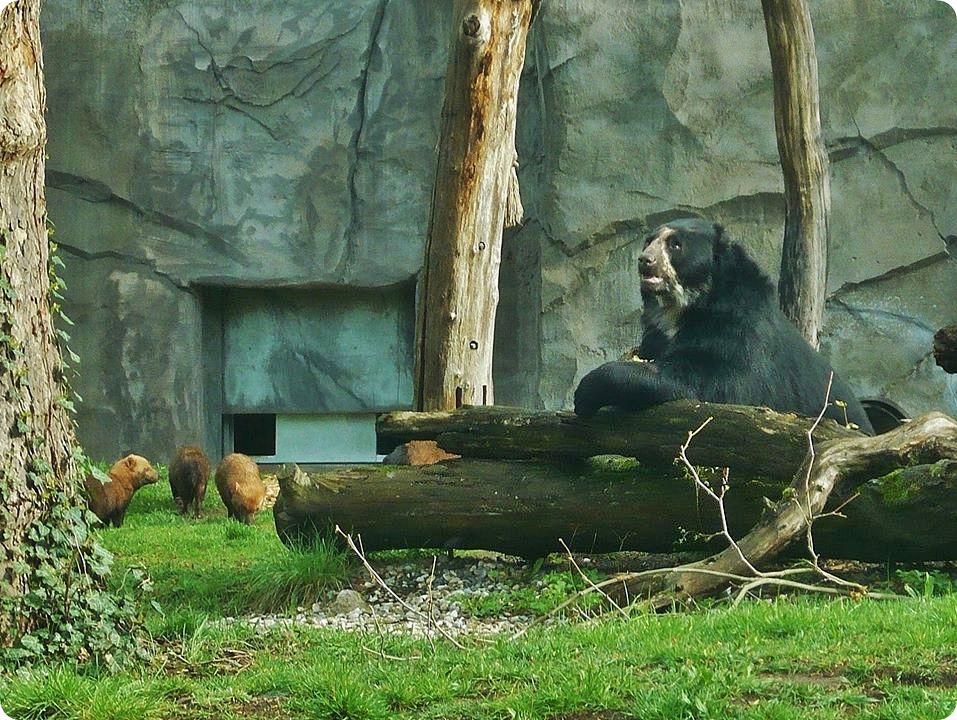
Andean Bear (Tremarctos ornatus) and Bush Dogs (Speothos venaticus)
Zoo Frankfurt, Germany
Photo © Stefano Capomagi
Frankfurt Zoo currently keeps their Andear Bears together with Bush Dogs (Speothos venaticus).
One of the most unusual combination of species was established in 2004 in South Lakes Safari Zoo in the United Kingdom where Andean Bears, Asian Small-clawed Otters (Aonyx cinereus), Capybaras (Hydrochoerus hydrochaeris) and South American Tapirs (Tapirus terrestris) coexisted. Afterwards Tufted Capuchins (Sapajus apella) and Brown-headed Spider Monkeys (Ateles fusciceps) have also been introduced into the exhibit, the later ones could climb on ropes from their own enclosure to the bears. According to WARD (2012, pers. comm.) the exhibit is still very successful, the park has yet to experience any problems between the different species. For the majority of the time, the animals keep to themselves and they have worked out which areas of the exhibit are for which species. However, they tolerate each other very well when they do come in close range. The institution believes that the secret to mixed species exhibits is ample space. If the animals have enough space to enable them distance between themselves and others, there should be no problem. Size of the mixed exhibit was around 3500 m². The animals are fed separately for the majority of the time so that keepers can monitor diets but in the summer there is an additional mixed scatter feed during the keepers conservation talk. This encourages the animals to forage for seeds, fruits throughout the rest of the day. Strangely enough, it seems that bears are almost the bottom of the hierarchy within the enclosure as they move away from some of the other species keeping their own space. Every animal has a specific protected area to retreat to if they choose that other species are not able or comfortable getting to.
Andean Bear (Tremarctos ornatus), Capybaras (Hydrochoerus hydrochaeris) and Asian Small-clawed Otters (Aonyx cinereus)
South Lakes Safari Zoo, Dalton-in-Furness, United Kingdom
Photo © Ben Gilbert
Andean Bear (Tremarctos ornatus) and Brown-headed Spider Monkey (Ateles fusciceps)
South Lakes Safari Zoo, Dalton-in-Furness, United Kingdom
Photo © Gayle Hyde
.jpg)
Andean Bear (Tremarctos ornatus) and South American Tapir (Tapirus terrestris)
South Lakes Safari Zoo, Dalton-in-Furness, United Kingdom
Photo © South Lakes Safari Zoo
Opinion
My overall impression is – and experiences reflect the same fact – that keeping different bear species in mixed exhibits can easily be problematic in many cases which is strengthened by numerous lethal attacks and fatalities caused by bears. All of these facts show that we have to handle this exhibitry type with bears very cautiously with special emphasis on preliminary studies and use of risk analysis methods.
ACKNOWLEDGEMENTS
I would like to thank all the persons very much who helped to improve this short summary with providing information and photographs as well, in particulare:
Linda ASKELUND Curator (The Skansen Foundation, Stockholm, Sweden); Anna BAUMANN Director (Natur- und Tierpark Goldau, Switzerland); Olivier BLANC (Juraparc, Vallorbe, Switzerland); Nils DIJKGRAAF Curator (Dierenpark Amersfoort, the Netherlands); Cécile DUBOIS Zoological Assistant (Safari de Peaugres, France); Heidi FELGNER Zoologist (Zoologischer Garten Leipzig, Germany); Andy FLACK Doctorandus (University of Bristol, BZG, United Kingdom); Christine GAGNON Biologist (Zoo sauvage de Saint-Félicien, Quebec, Canada); Cordula GALEFFI Curator (Zoo Zürich, Switzerland); Allan GALWAY Studbook Keeper and Zookeeper (Belfast Zoological Gardens, United Kingdom); dr. Jean-Christophe GERARD Veterinarian (Espace Zoologique de Saint-Martin-la-Plaine, France); Wolf-Dietrich GÜRTLER Zoologist (ZOOM Erlebniswelt, Gelsenkirchen, Germany); Dean HARRISON Park Owner (Out of Africa Wildlife Park, Camp Verde, Arizona, United States of America); Sander HOFMAN Curator (Zoo Antwerpen, Belgium); Sabrina HÖFT Biologist (Zoo Schwerin, Germany); Jenna HUNT Senior Mammal Keeper (Jersey Zoo, Trinity, Channel Islands); Kris JANSEN Head Keeper and Curator (Dierenrijk, Mierlo, the Netherlands); Achim JOHANN Director (NaturZoo Rheine, Germany); José KOK Studbook Keeper (Ouwehands Dierenpark Rhenen, the Netherlands); dr. Lydia KOLTER Curator (Kölner Zoo, Germany); dr. Heike KÜCK Director (Zoo am Meer, Bremerhaven, Germany); Dirk LODDENKEMPER Curator (Zoo Zürich, Switzerland); dr. Helmut MÄGDEFRAU Director (Tiergarten Nürnberg, Germany); Sandra MOLLOY Registrar/Research and Conservation Coordinator (Dublin Zoo, Ireland); Klaus MÜLLER-SCHILLING Curator (Erlebnis-Zoo Hannover, Germany); Colin NORTHCOTT Curator (Dartmoor Zoological Park, United Kingdom); Monika ONDRUŠOVÁ Assistant of Director (Zoologická zahrada Ostrava, Czech Republic); John PARTRIDGE Curator (Bristol Zoo Gardens, United Kingdom); Zsuzsa PETRÓ Head of Department (Nyíregyházi Állatpark, Hungary); dr. Mélanie PIGNOREL Veterinarian (Espace au Safari de Peaugres, France); Ashton POWELL Public Relations Director (Out of Africa Wildlife Park, Camp Verde, Arizona, United States of America); Sandra REICHLER-DANIELOWSKI Curator (Zoo Heidelberg, Germany); dr. Marc ROSSET Curator (Tierpark Dählhölzli, Bern, Switzerland); Wineke SCHOO Park Manager & Biologist (Burgers’ Zoo, Arnhem, the Netherlands); Kim VAN de PUT Curator (Burgers’ Zoo, Arnhem, the Netherlands); Lars VERSTEEGE Curator (Safaripark Beekse Bergen, Hilvarenbeek, the Netherlands); Samantha WARD Conservation & Research Manager (South Lakes Safari Zoo, Dalton-in-Furness, United Kingdom)
As well as I would like to thank all the persons very much who helped to improve this document with providing further photographs, their names are listed below:
Tamás BOROS, Arthus BOUTIN, Stefano CAPOMAGI, Eelke DENEKAMP, Tom van DEUREN, Jörg EVERDING, Örs GÖRÖG, Gayle HYDE, Neil INGRAM, Jana KANICHOVÁ, Ingrid KLAUS, Theo KRUSE, Christiaan LUTTENBERG, Anita MAZÁCS, Klaus ROBIN, Tim PRESTON, Jan VERMEER
References:
AMES, A. 1998. Environmental Enrichment for Bears. In: FIELD, D. A. Guidelines for Environmental Enrichment. Association of British Wild Animal Keepers, Pp. 93-108.
AZA Ungulate TAGs. 2017. Ungulate Taxon Advisory Groups Mixed-species Exhibit Manual. Association of Zoos and Aquariums, Silver Springs, MD. pp 1031.
ASAKURA, S. 1968. A note on the breeding of Vulpes vulpes japonica at Tokyo Tama Zoo. International Zoo Yearbook 8:20-21.
BAUMANN, A. & WEHRLE, M. 2011. Das Zusammenleben von Bär und Wolf in einer neuen Gemeinschaftsanlage – Beschrieb über 1½ Jahre. In: Der Zoologische Garten 80(3):93-105.
COWAN, K., DARWENT, M. & RIVA, C. 1999. The design of First Impressions, a new multi-species enclosure at Jersey Zoo. The Durrell Wildlife Conservation Trust. The Dodo 35:8-25.
DEE, M. 1988. The management of spectacled bears at the Los Angeles Zoo. Proceedings of the First International Symposium on the Spectacled Bears, Lioncoln Park Zoo, Chicago, Illinois, USA. October 1988 1, 111-113.
DORMAN, N. & BOURNE, D. C. 2009. Canids and ursids in mixed-species exhibits. International Zoo Yearbook (2010) 44: 75-86.
EIJK, v.d. P. 1995. Managing the bears in the Bear Forest in Rhenen. In: KOENE, P. (ed): Large Bear Enclosures. An International Workshop on Captive Bear Management, Ouwehands Zoo, Rhenen, The Netherlands, June 18-20, 1995, Pp. 15-16.
FIEDLER, W. 1976. Tiergarten Schönbrunn: Geschichte und Aufgeben. Verb.d.wiss.Ges. Österr., Wien, Pp. 197.
FISCHBACHER, M. & SCHMID, H. 1999. Feeding enrichment and stereotypic behavior in spectacled bears. Zoo Biology 18:363-371.
HAMMER, G. 2002. Mixed species exhibits involved mammals: stock report and problems. Dissertation. Naturwissenschaftliche Fakultät Universität Salzburg.
HETTLER, L. 1998. News in Brief in AZA Communiqué. International Zoo News Vol. 45/2 (No. 283), 104-124.
IUDZG/CBSG (IUCN/SSC) 1993. Az Állatkertek Természetmegőrzési Világstratégiája. A világ állatkertjeinek és akváriumainak szerepe a Föld természeti értékeinek megőrzésében. Budapest Főváros Állat- és Növénykertje, Budapest.
JOHANN, A. 2011. Die neue Bären-Anlage im NaturZoo Rheine – Planung, Konzept und Erfahrungen. Der Zoologische Garten N. F. 80 (2011) Pp. 1-28.
KNOTT, C. 2005. Miért van szükség a környezetgazdagításra? In: Golovanova B. (szerk.) 2005. Környezetgazdagítás. Kittenberger Kálmán Növény- és Vadaspark Szolgáltató Kht.
KOLTER, L. KAMPHORST, N. F. & RUVEN, S. A. W. The design of new bear facilities. EEP Ursid Husbandry Guidelines, Chapter 2
LARSSON, H. O. 1995. Management and design. In: KOENE, P. (ed): Large Bear Enclosures. An International Workshop on Captive Bear Management, Ouwehands Zoo, Rhenen, The Netherlands, June 18-20, 1995, Pp. 63-65.
LUBIW-HAZARD, N. 2000. American black bear: a comparison of husbandry and housing practices. Toronto, Zoocheck Canada Inc., World Society for the Protection of Animals, Ontario Zoo Working Group.
SCHERREN, H. 1907. Some notes on hybrid bears. Proceedings of the Zoological Society of London 1907: 431-435.
THOMAS, W. D. 1968. Mixed exhibit for polar bears and arctic foxes Thalarctos maritimus and Alopex lagopus at Omaha Zoo. International Zoo Yearbook 8, Pp. 18-19.
ZIEGLER, T. 2002. Selected Mixed Species Exhibits in Zoological Gardens. Primate Report 64.
Comments

